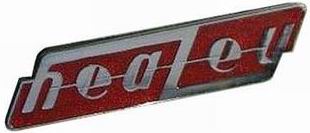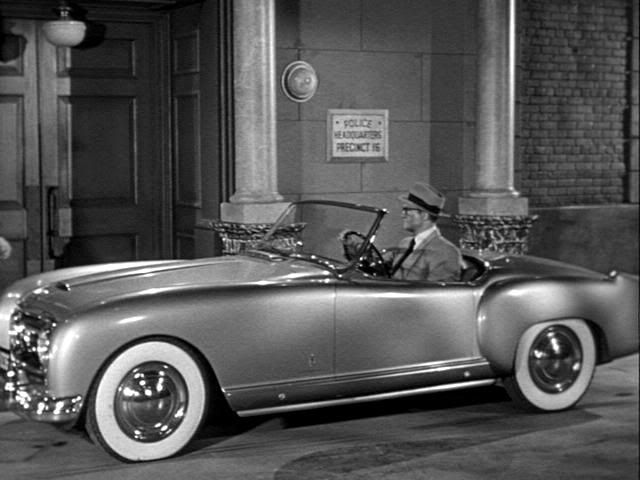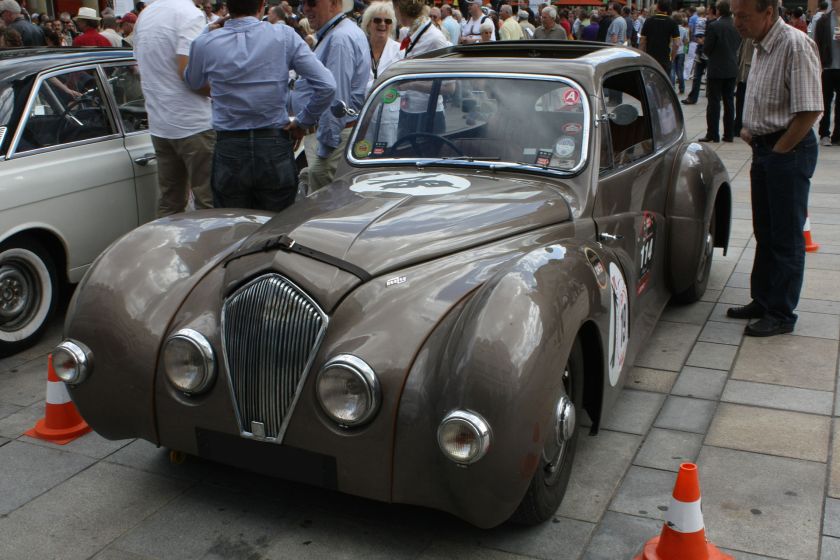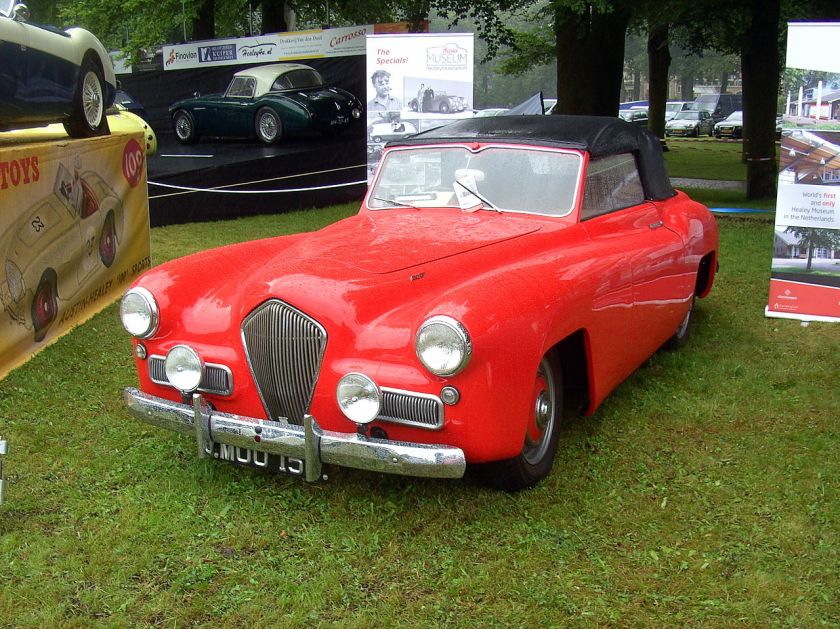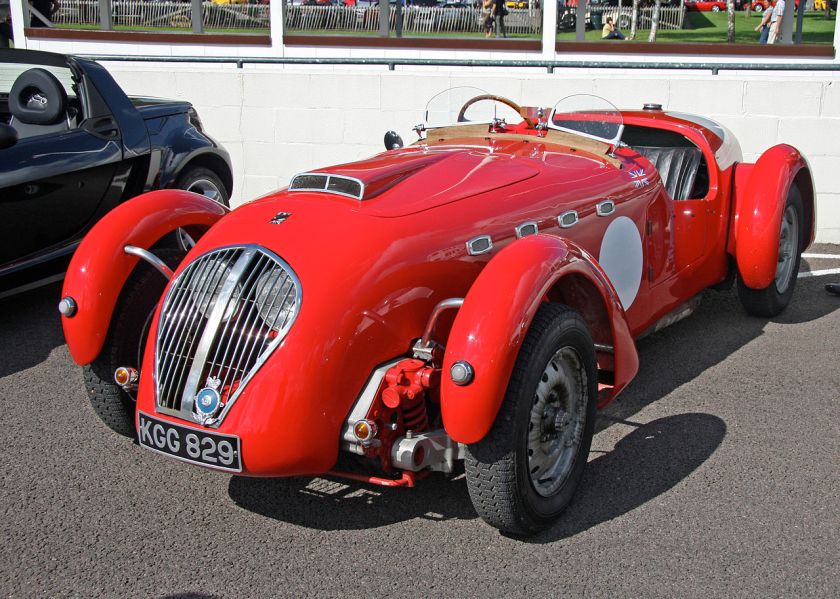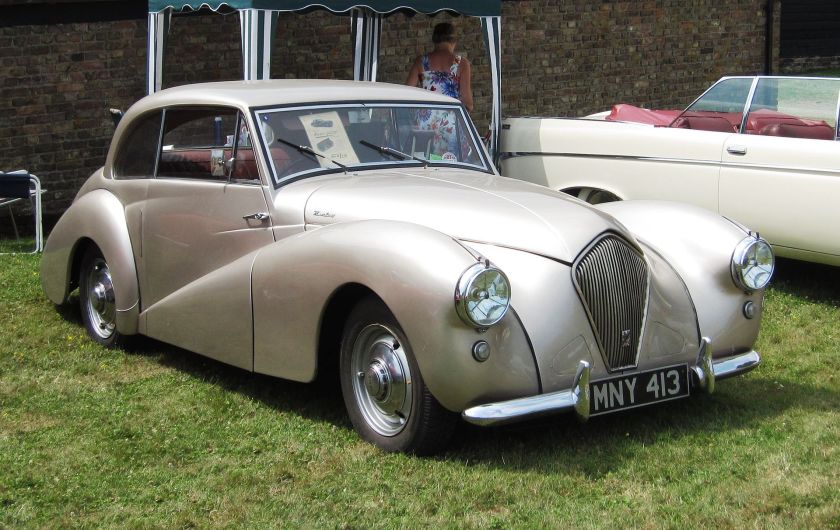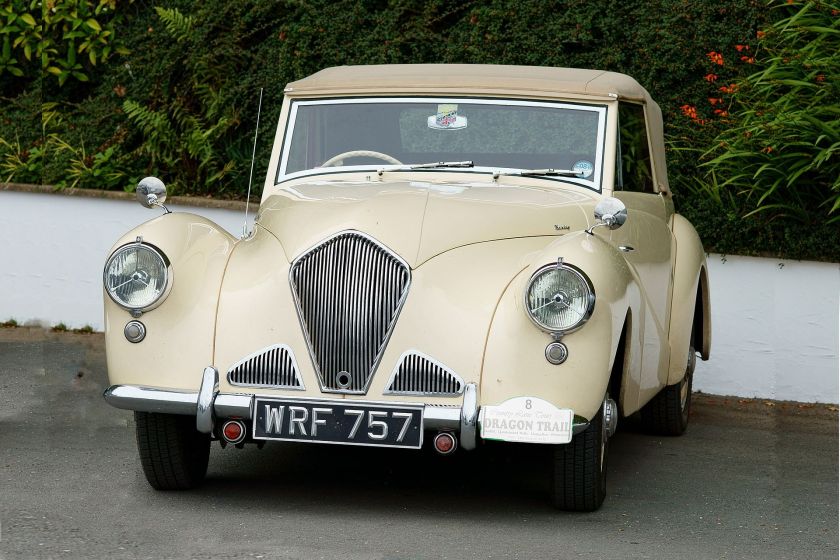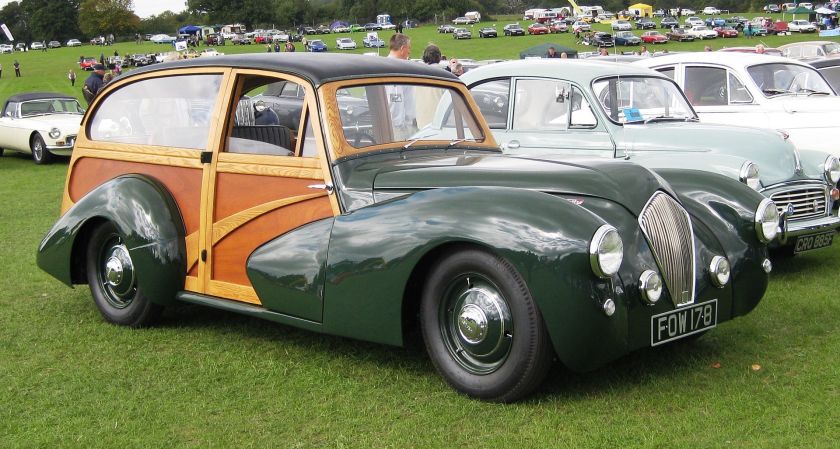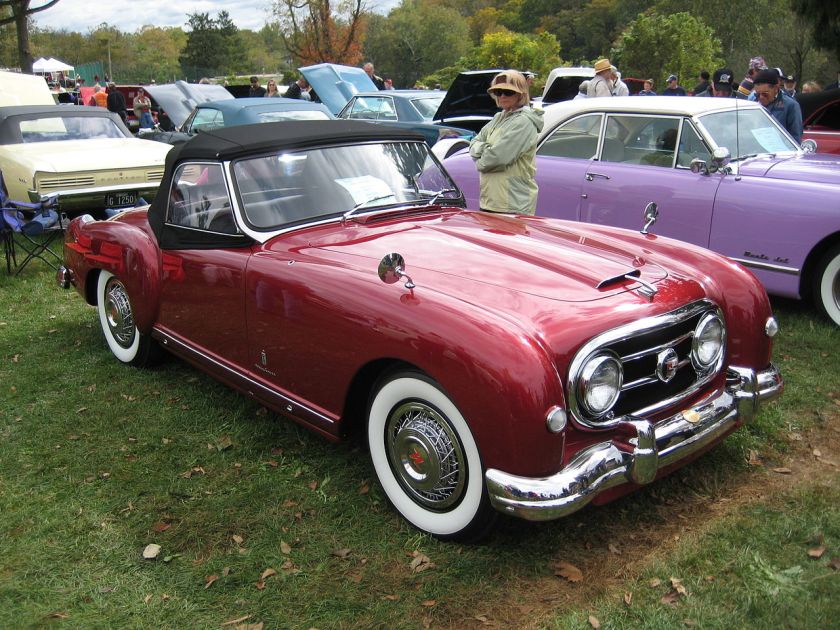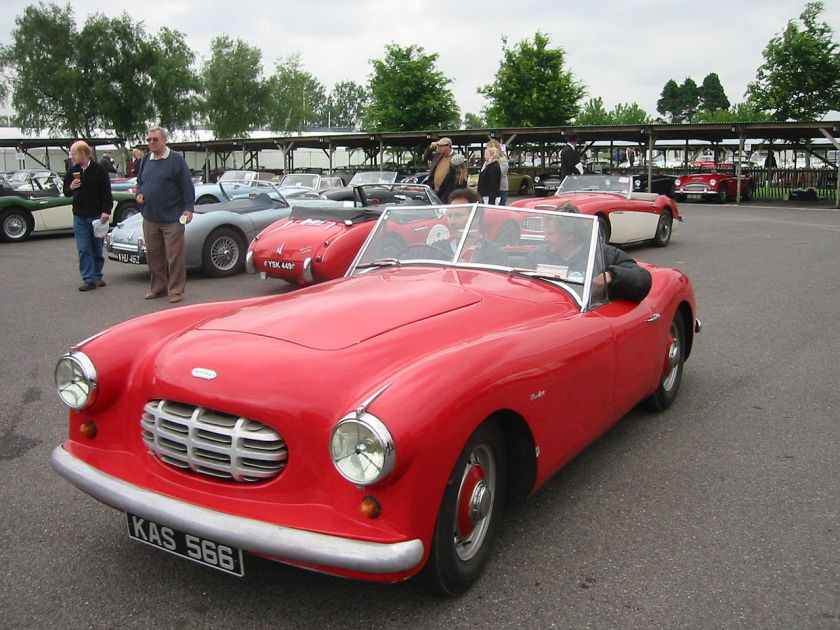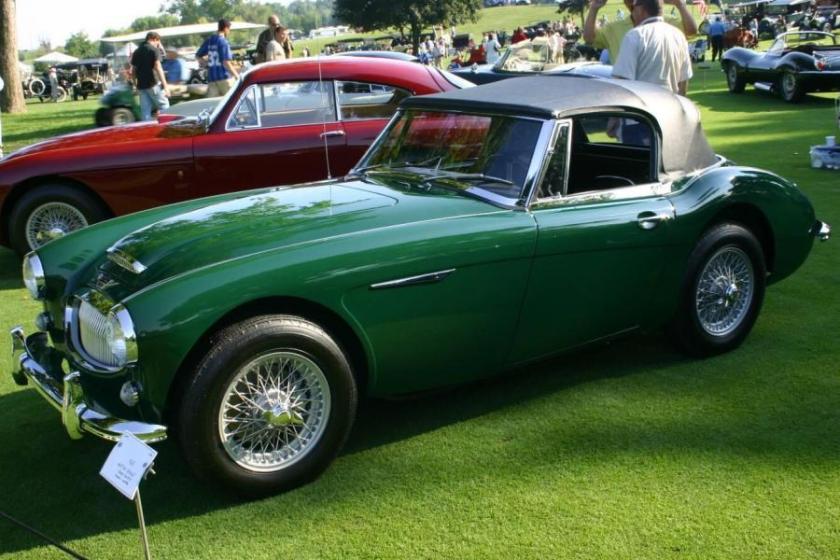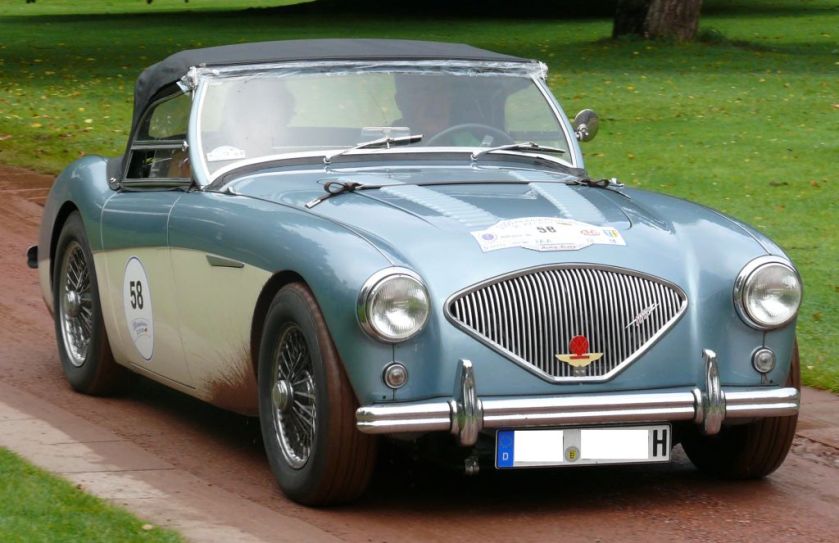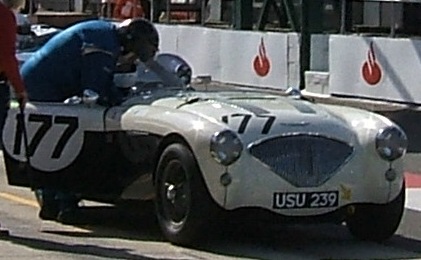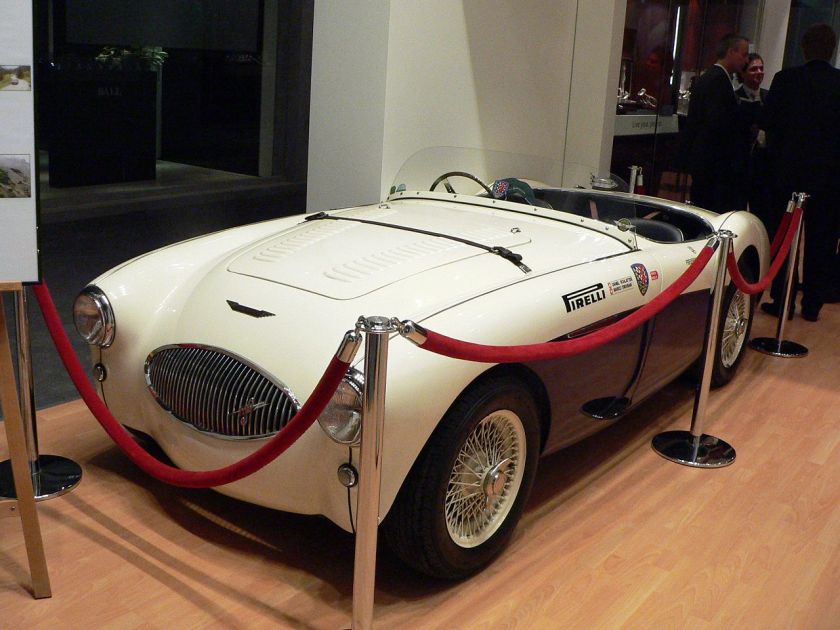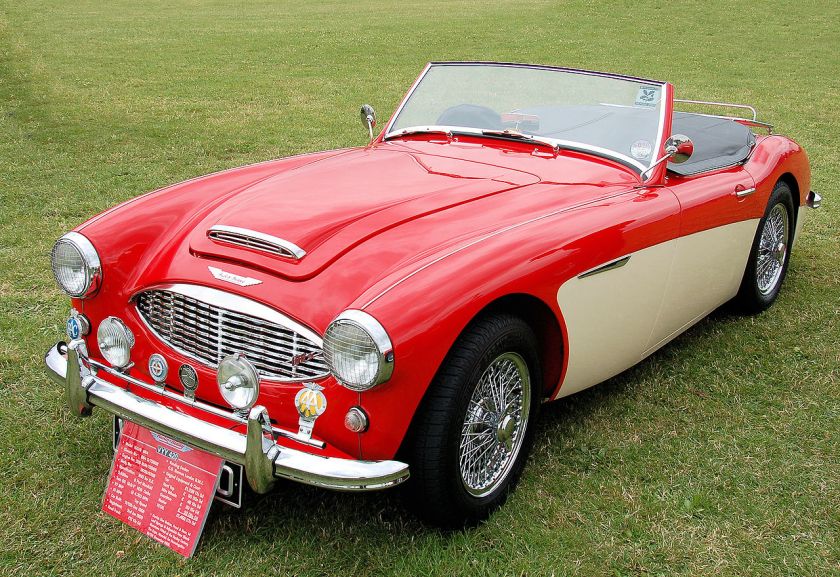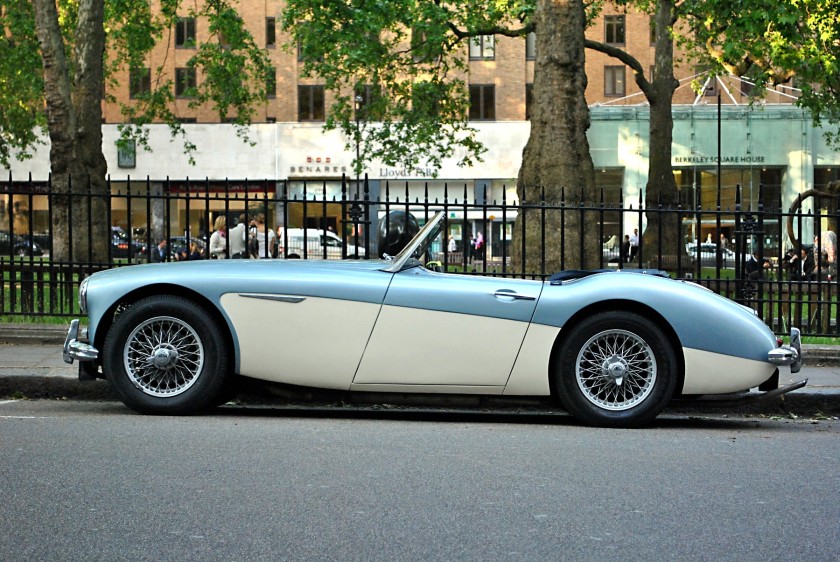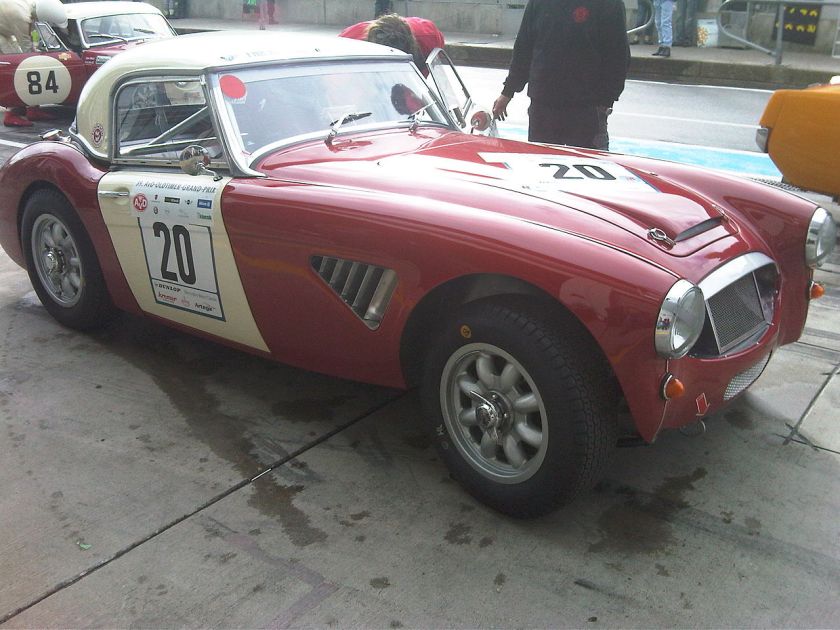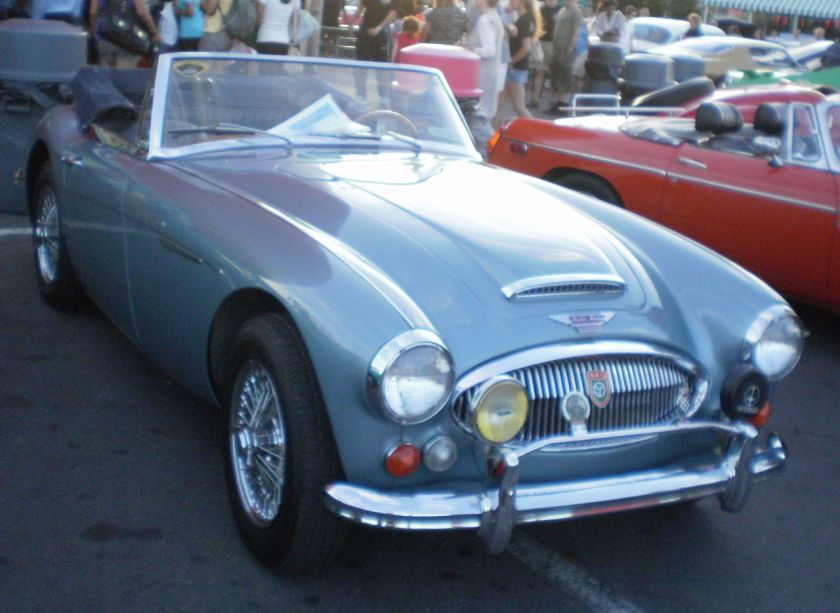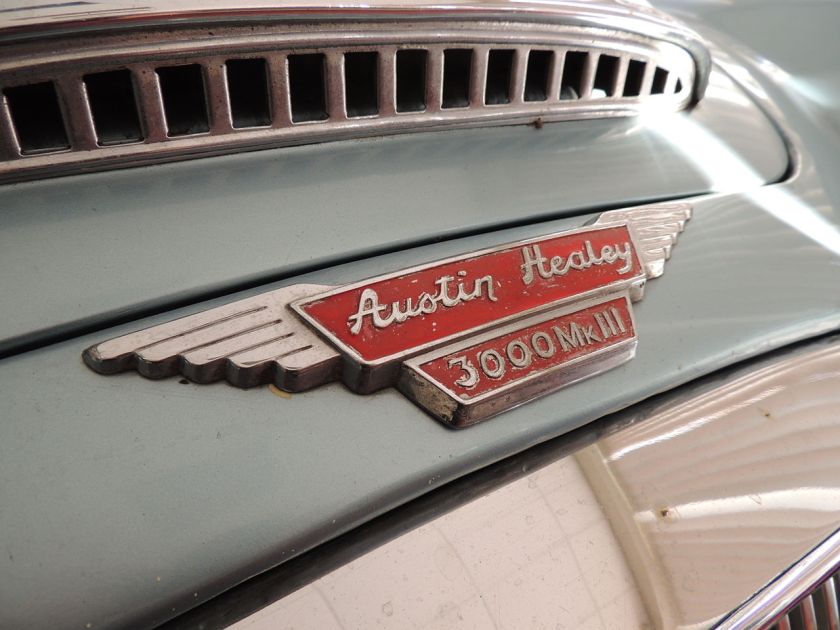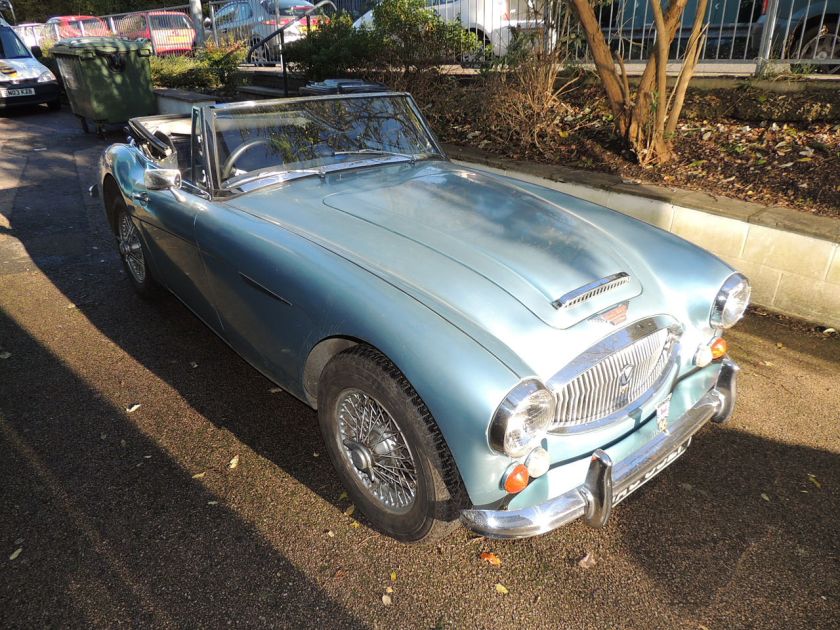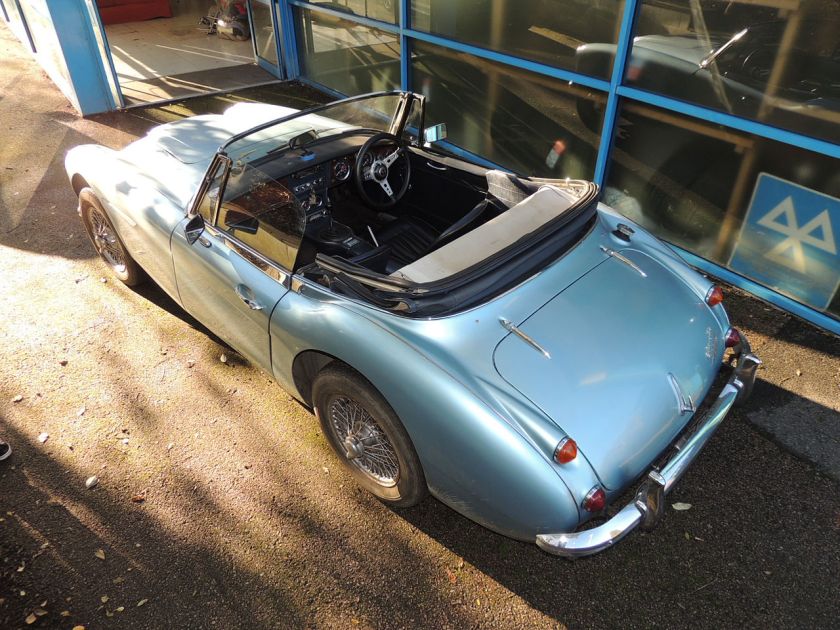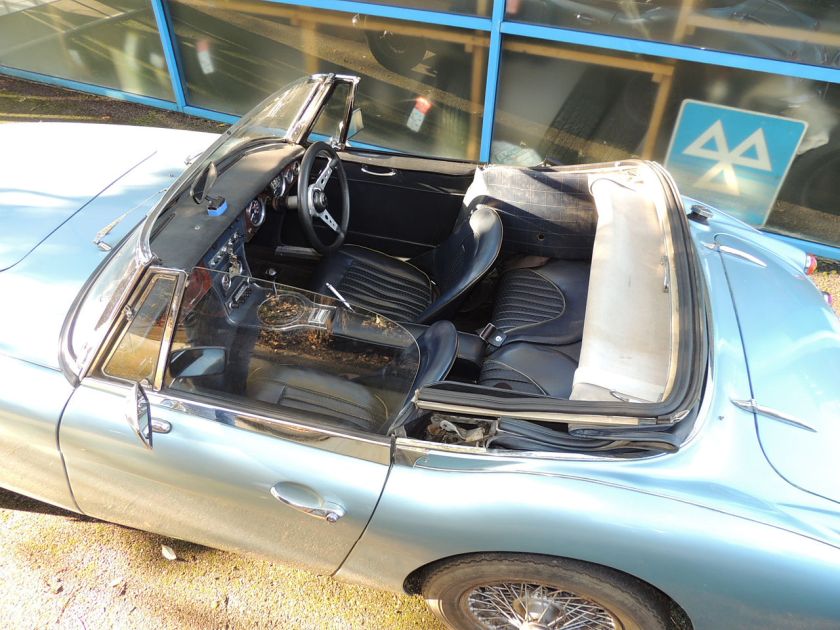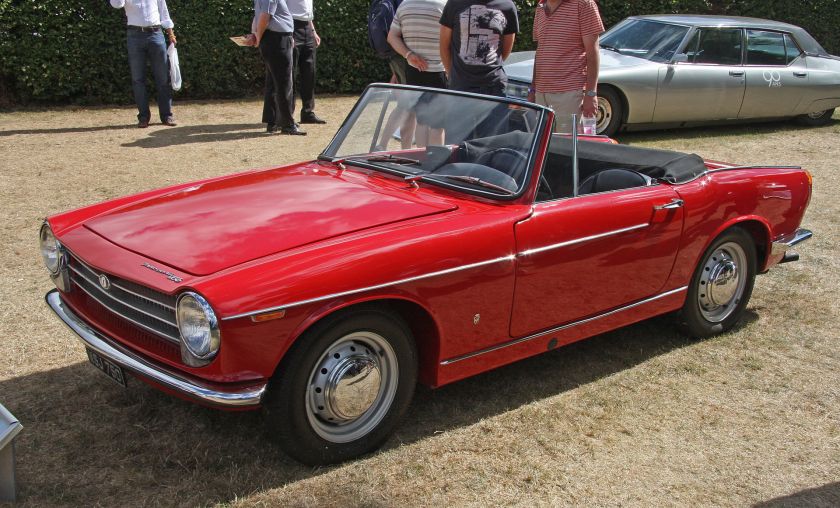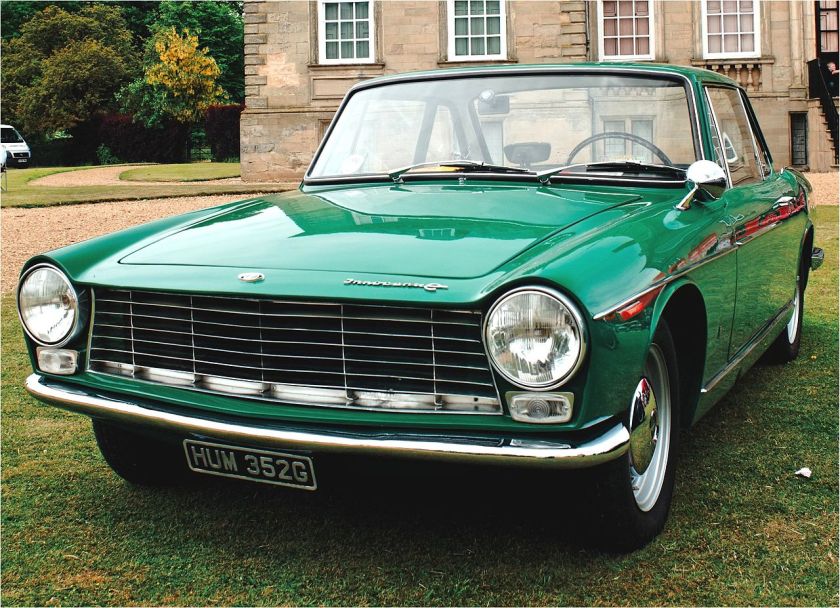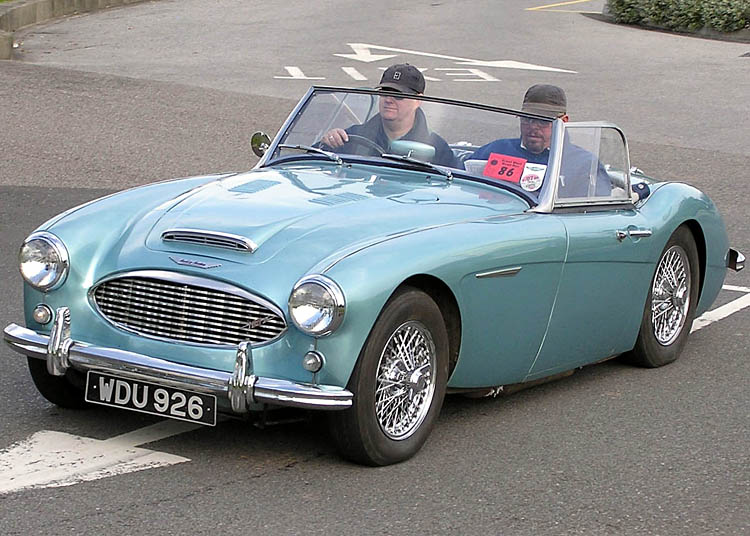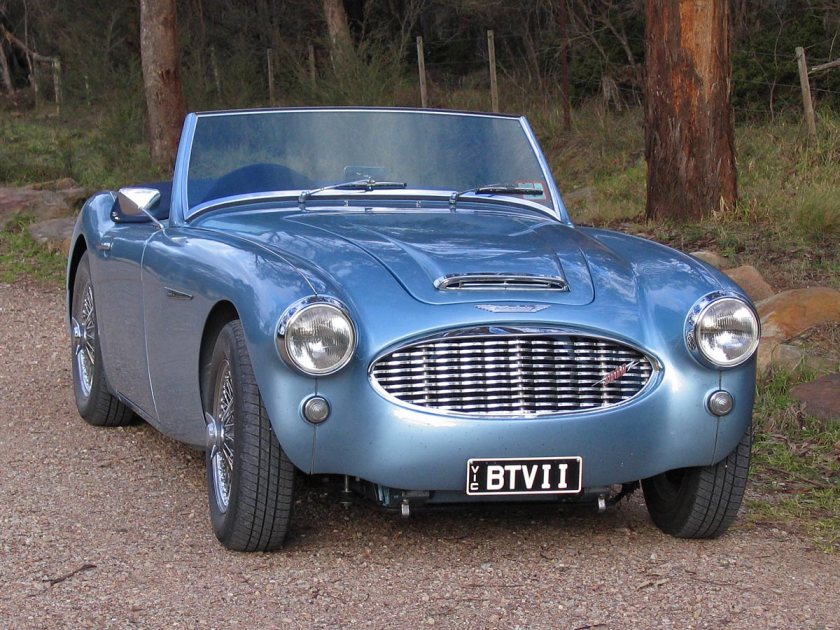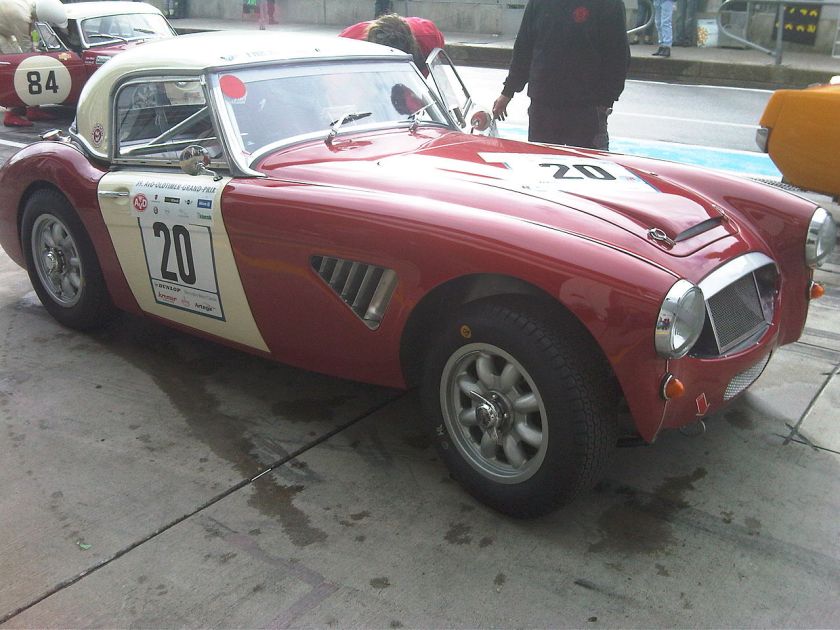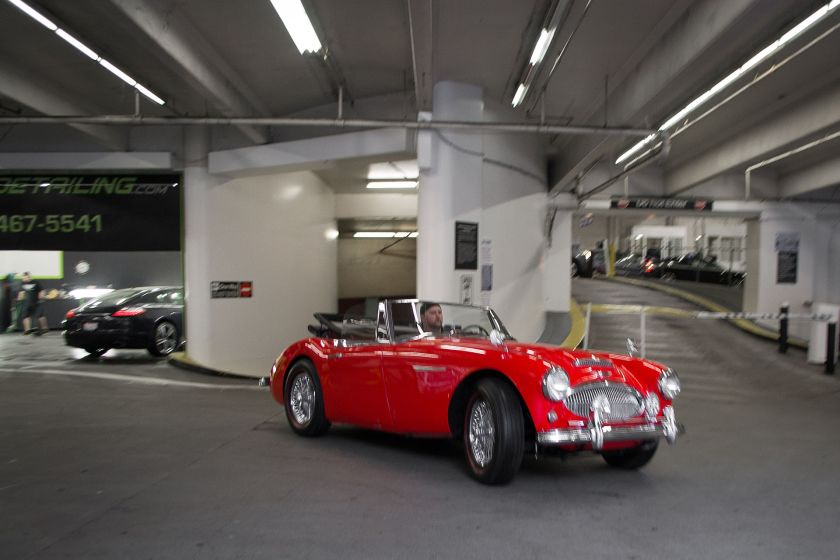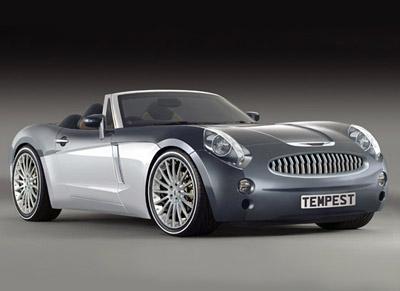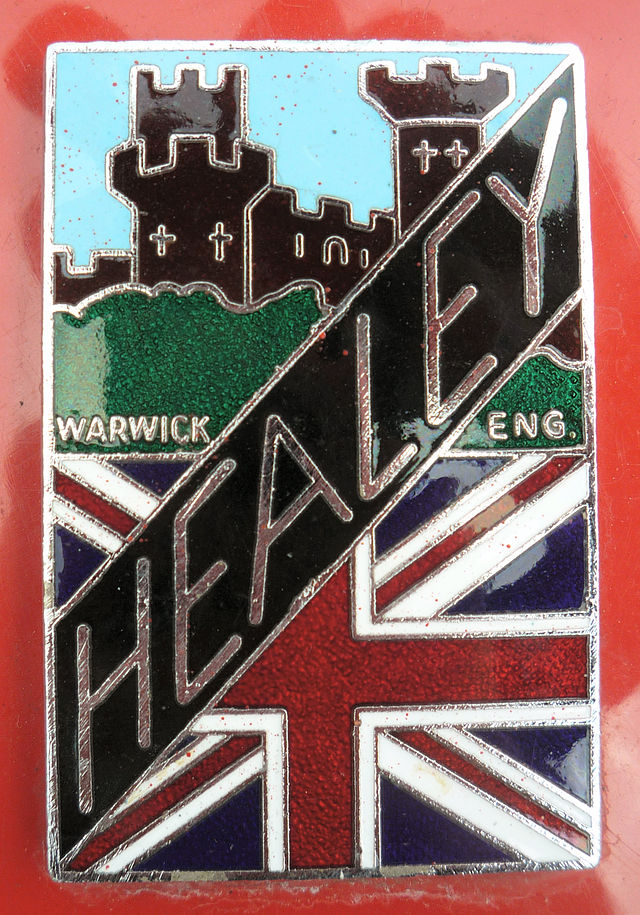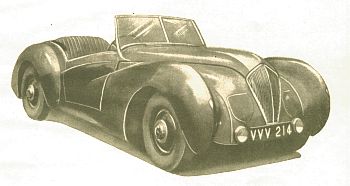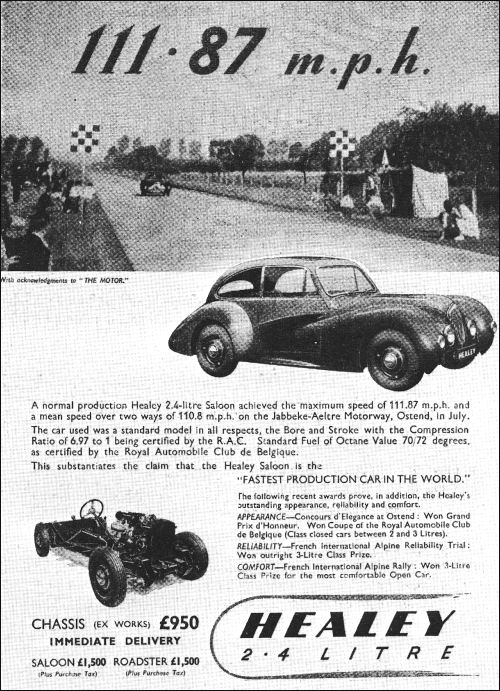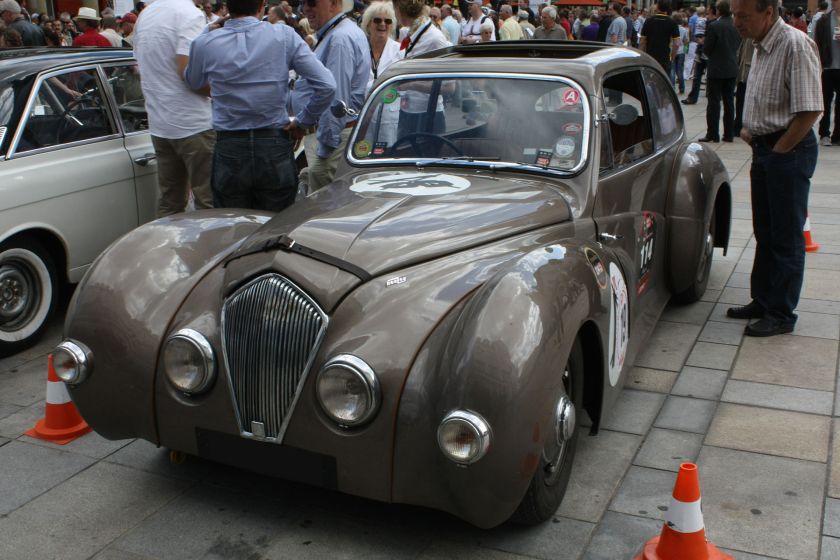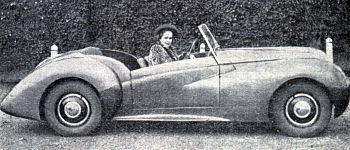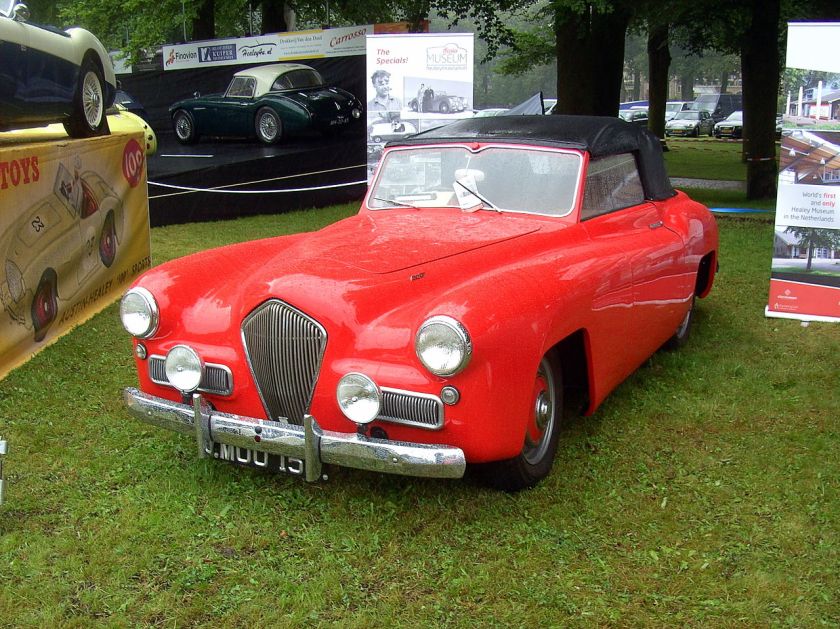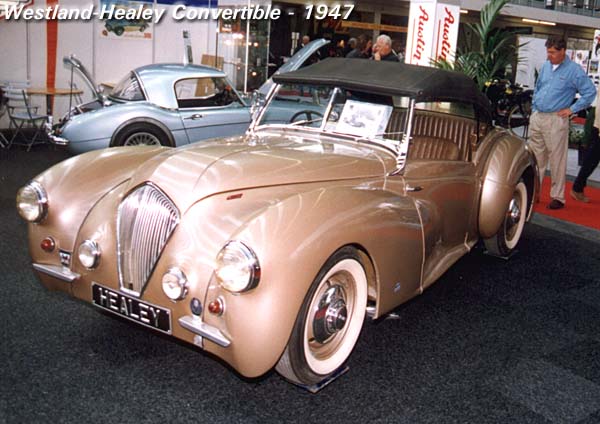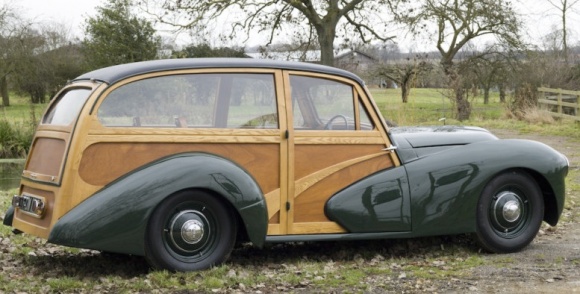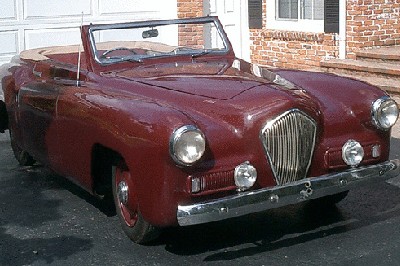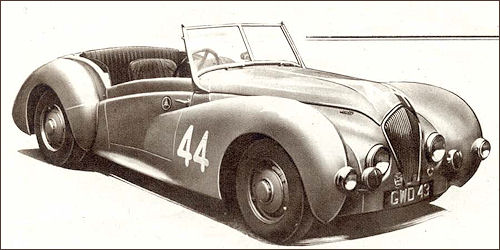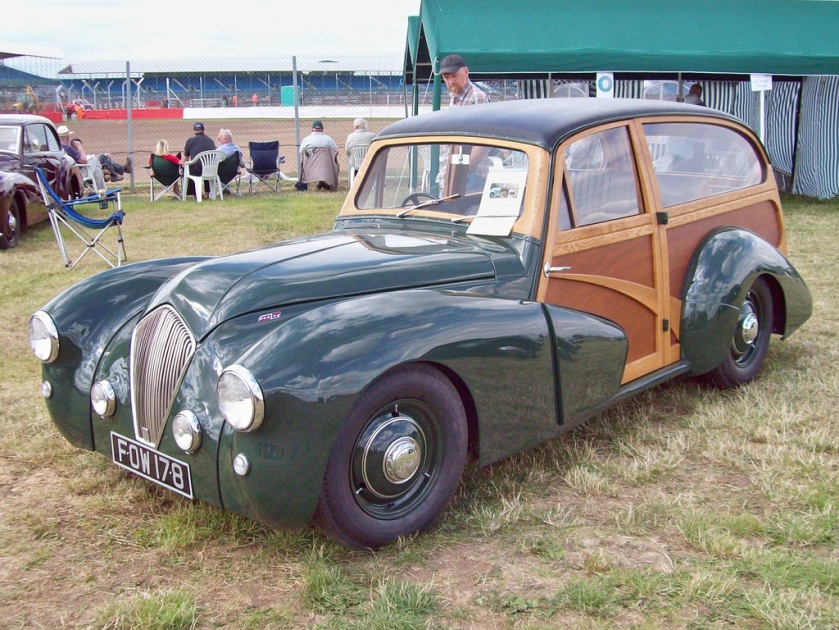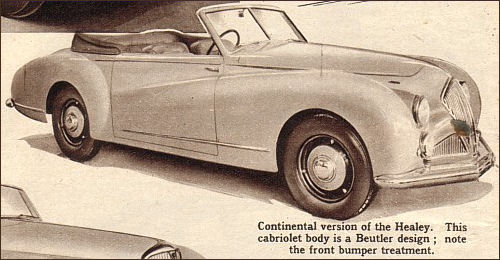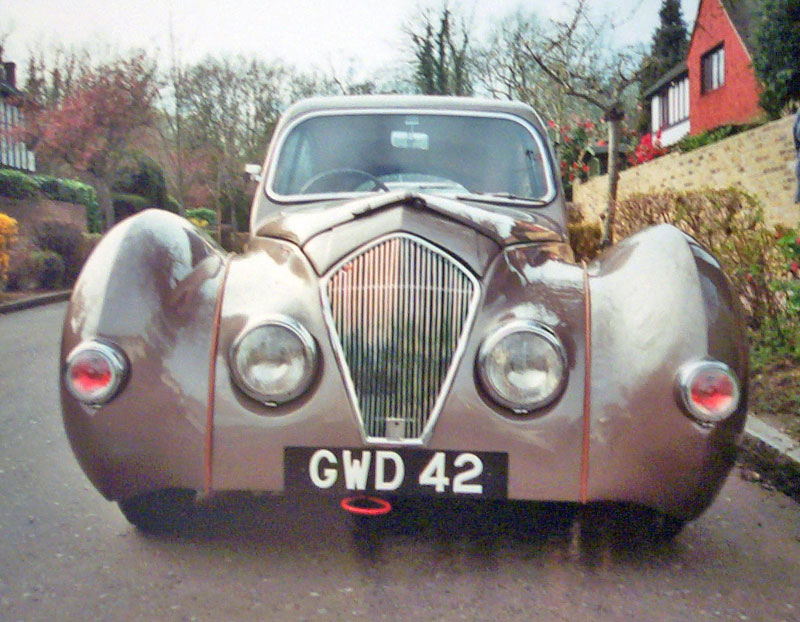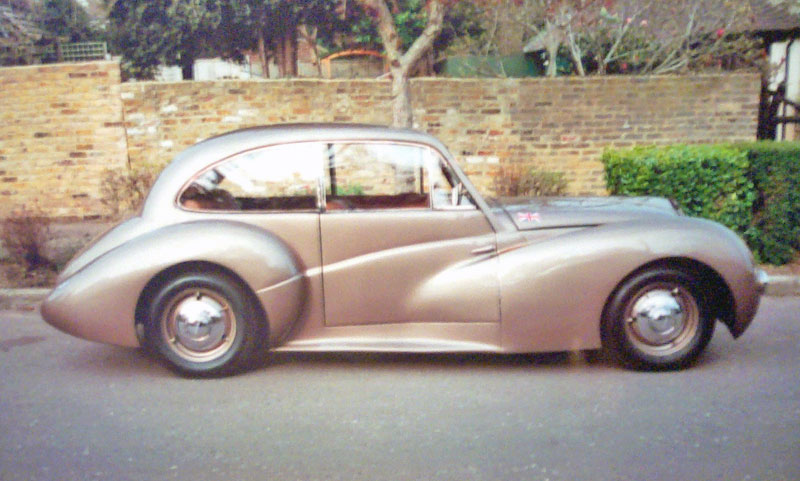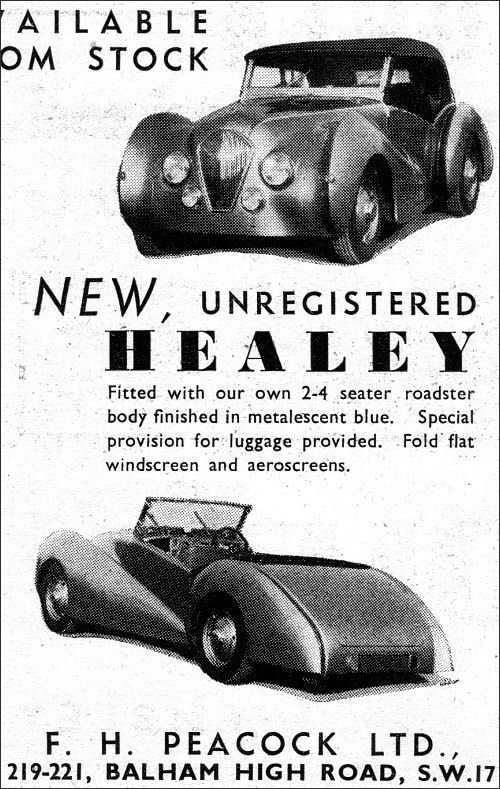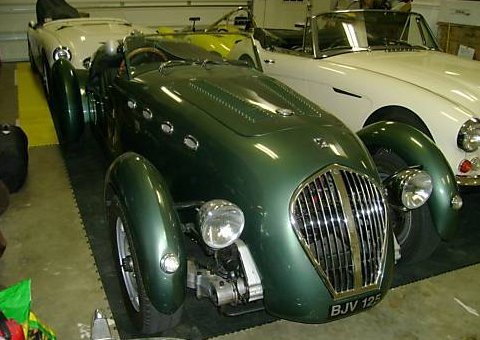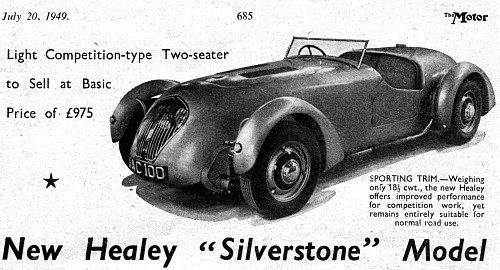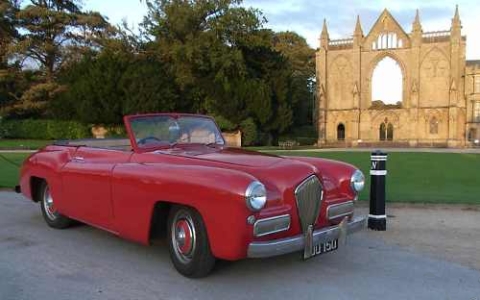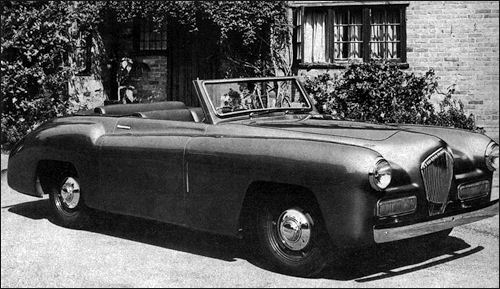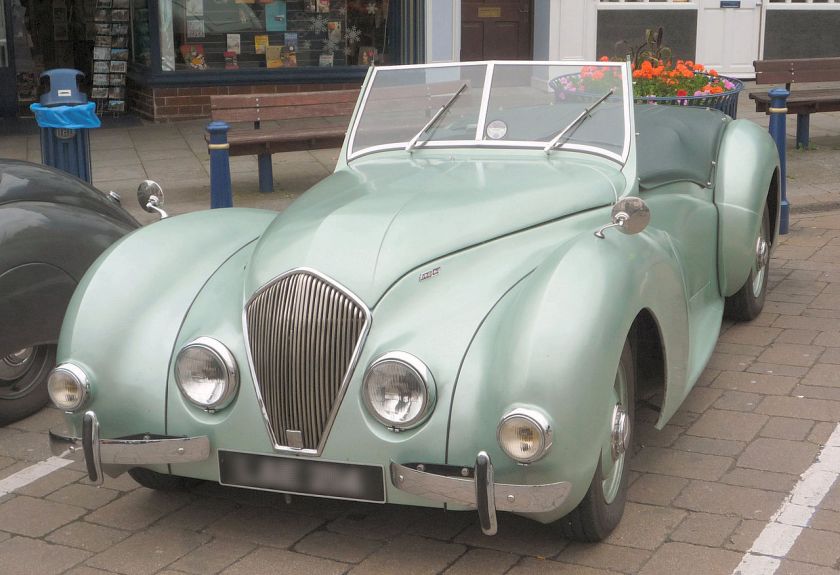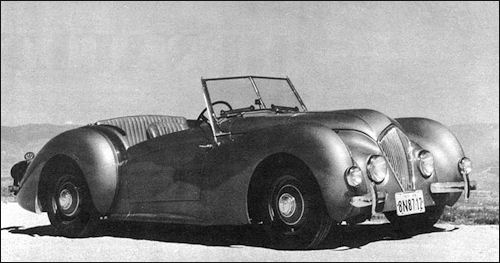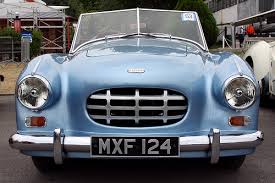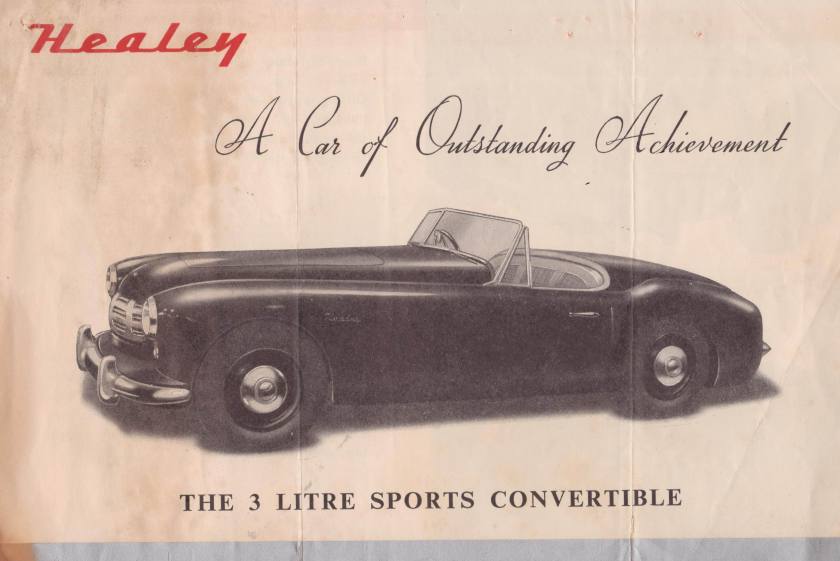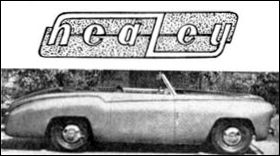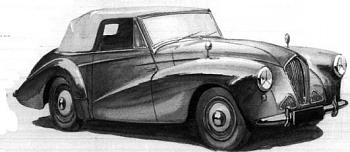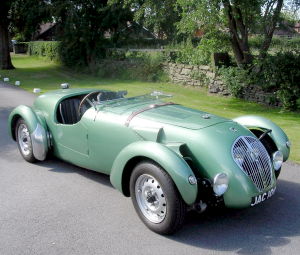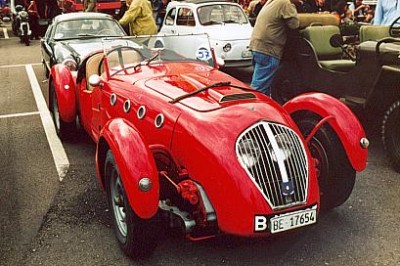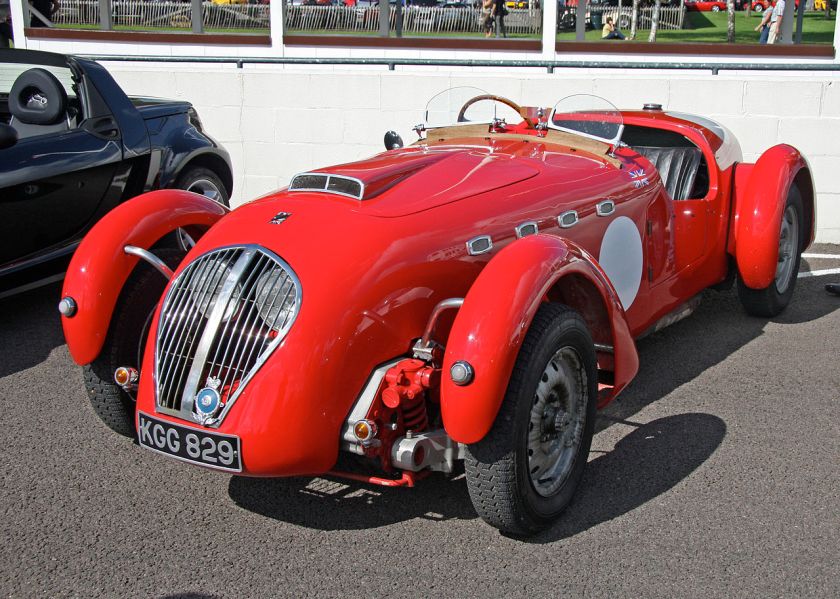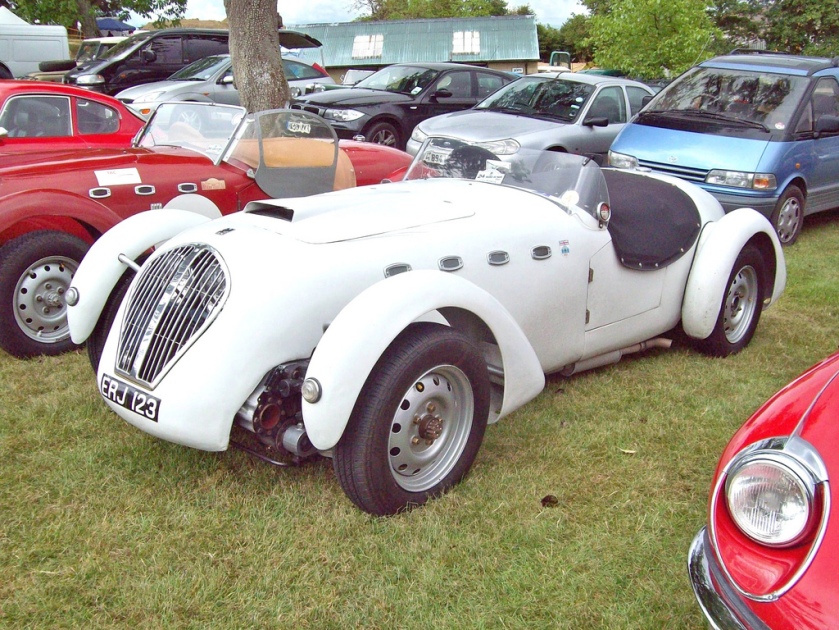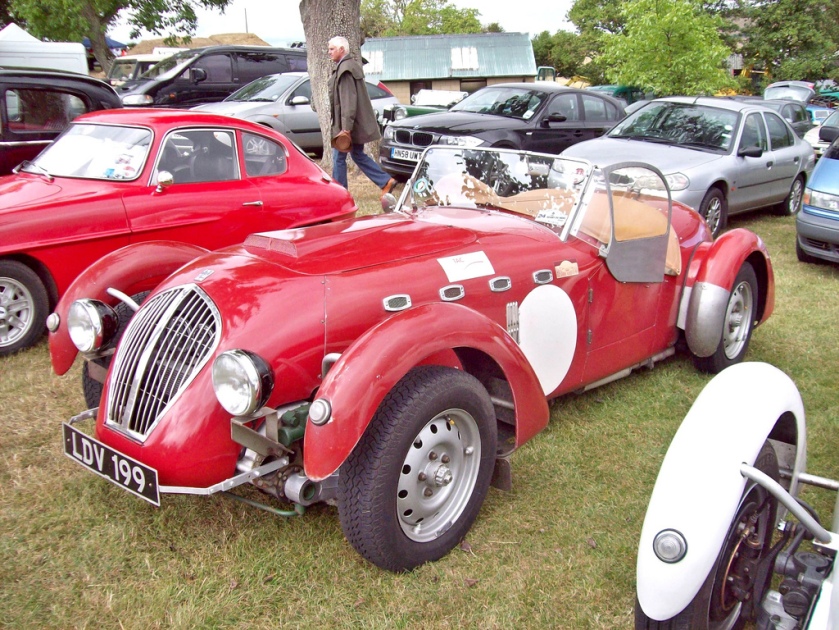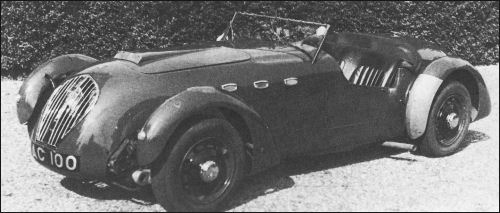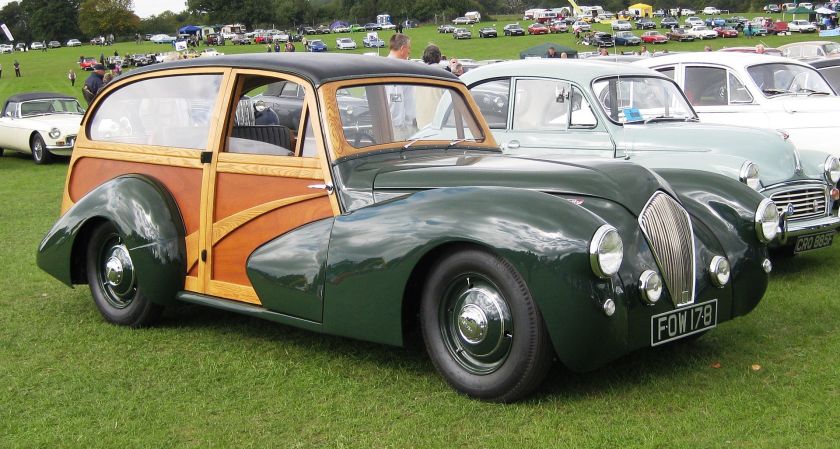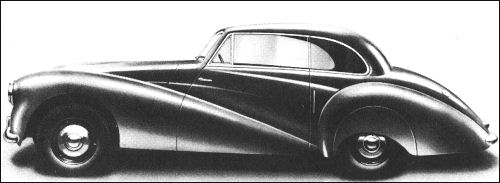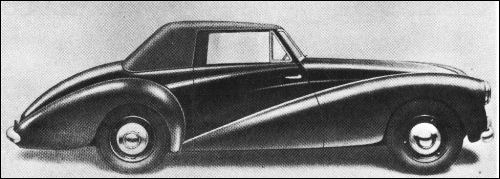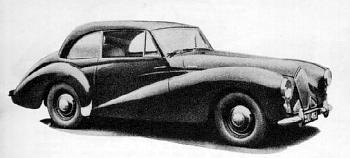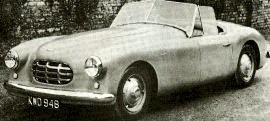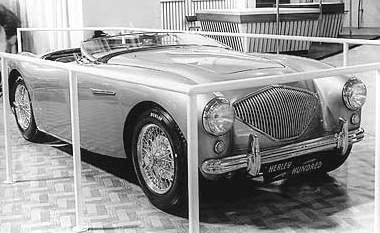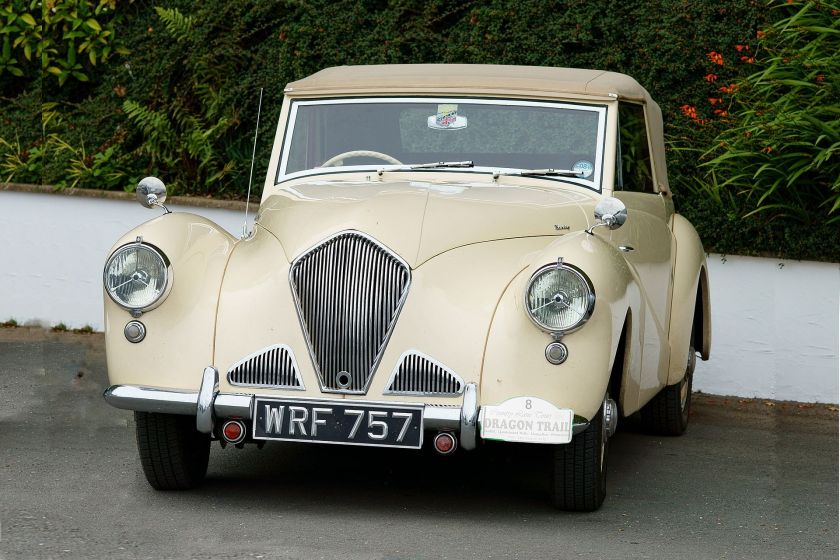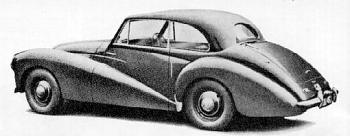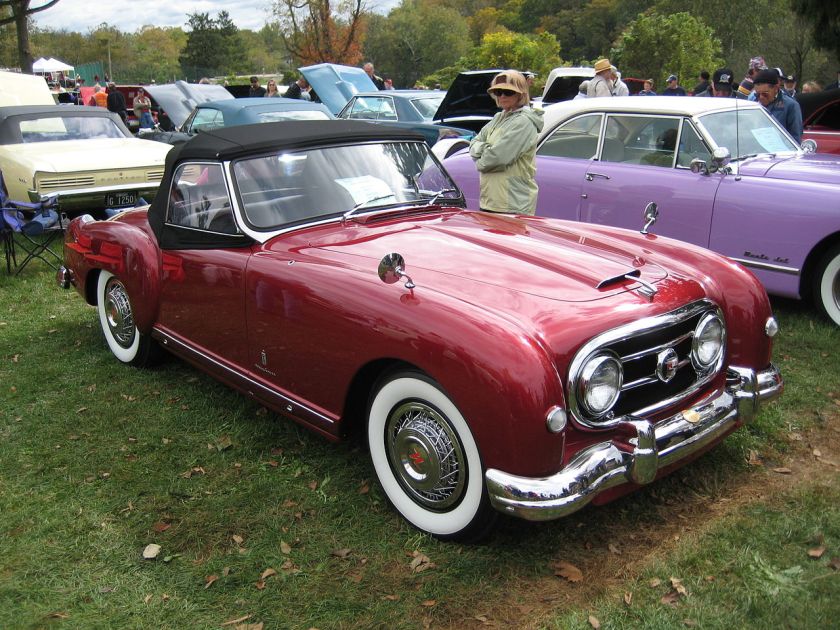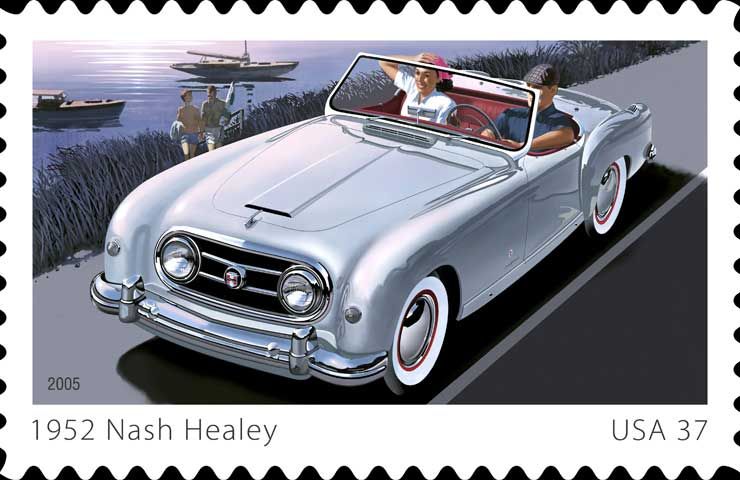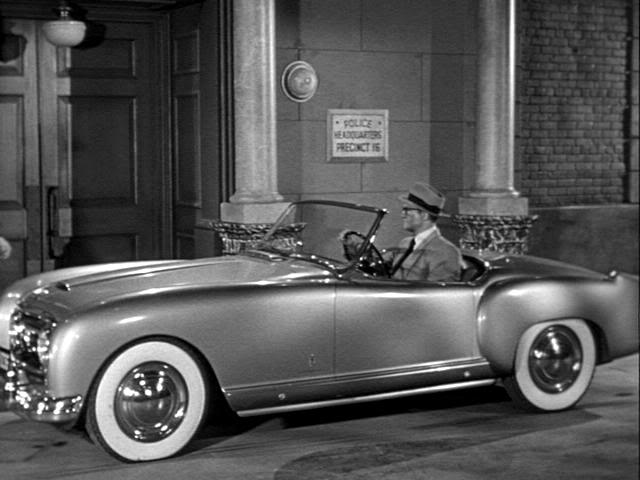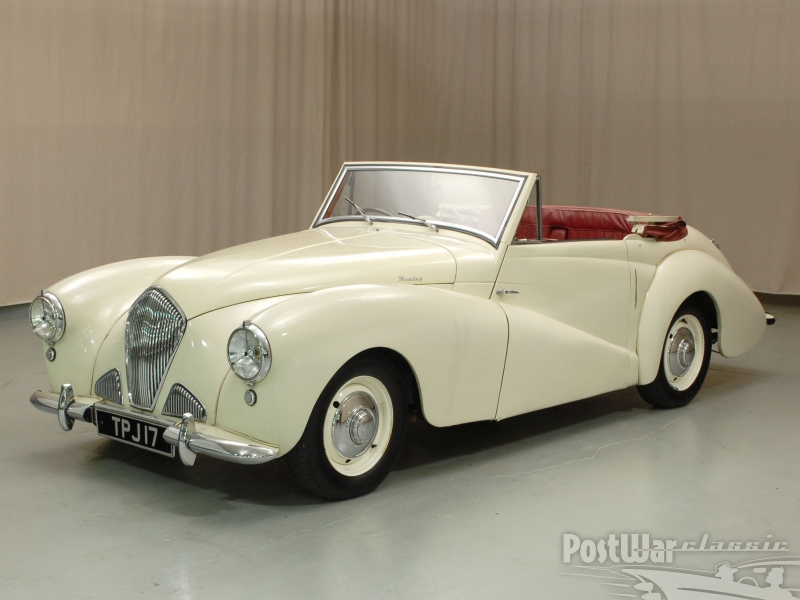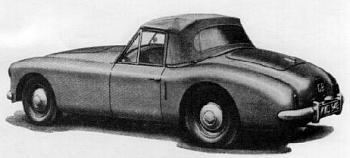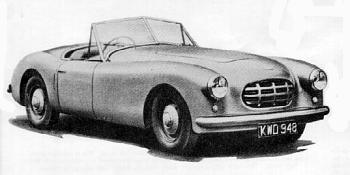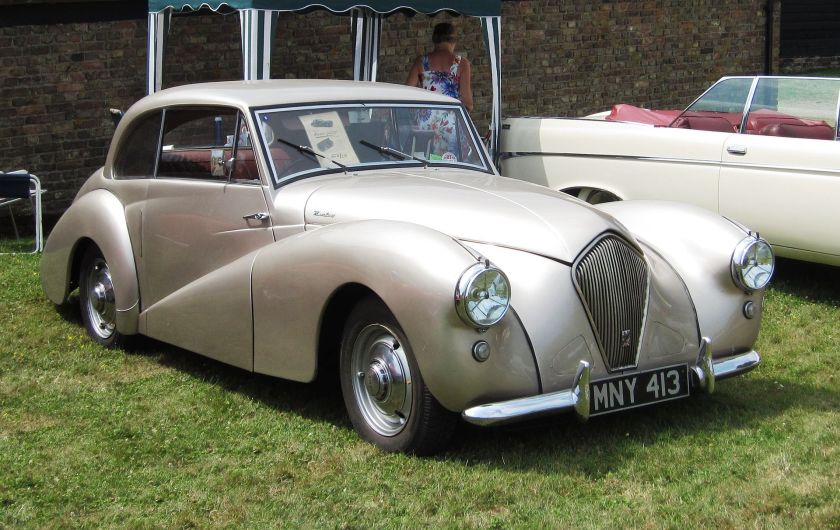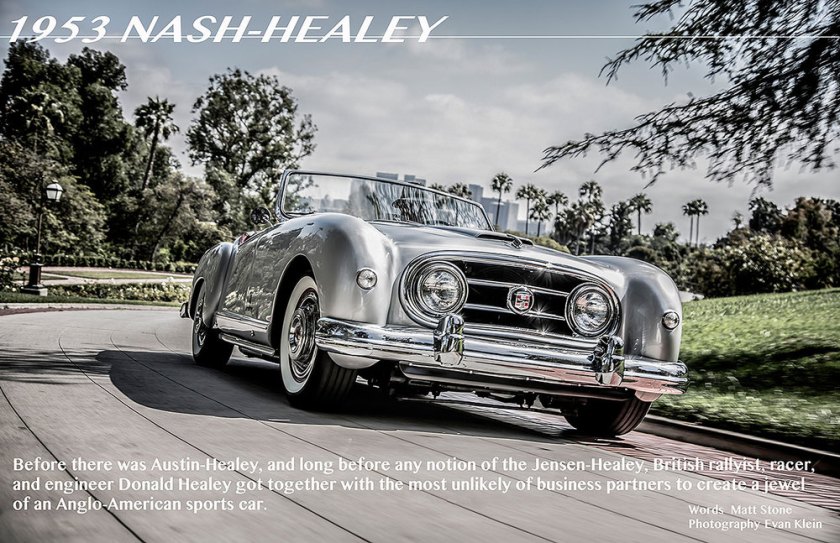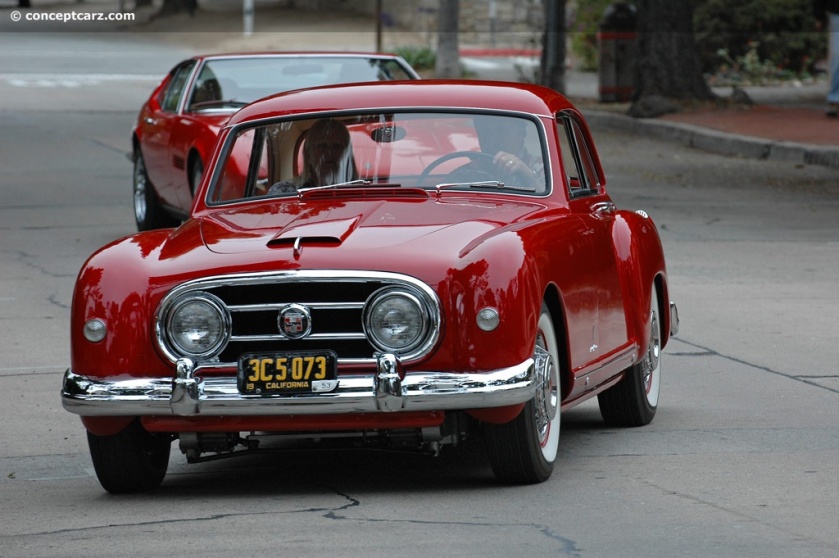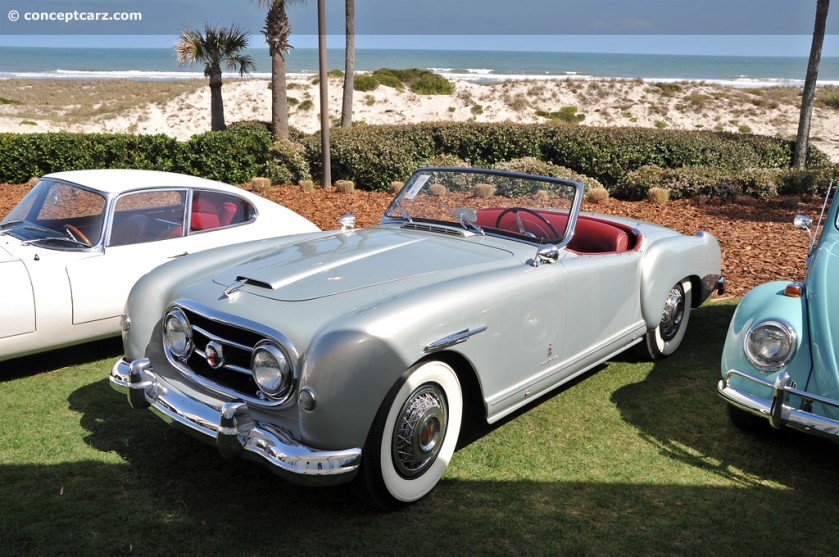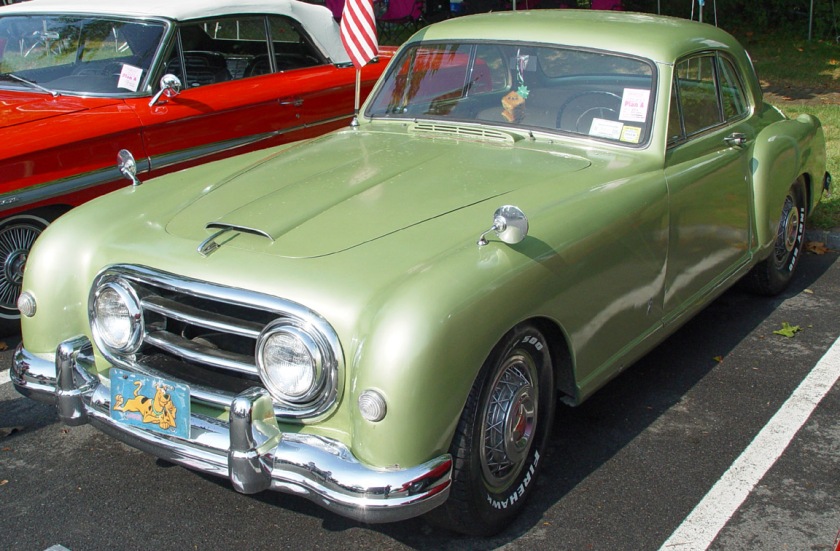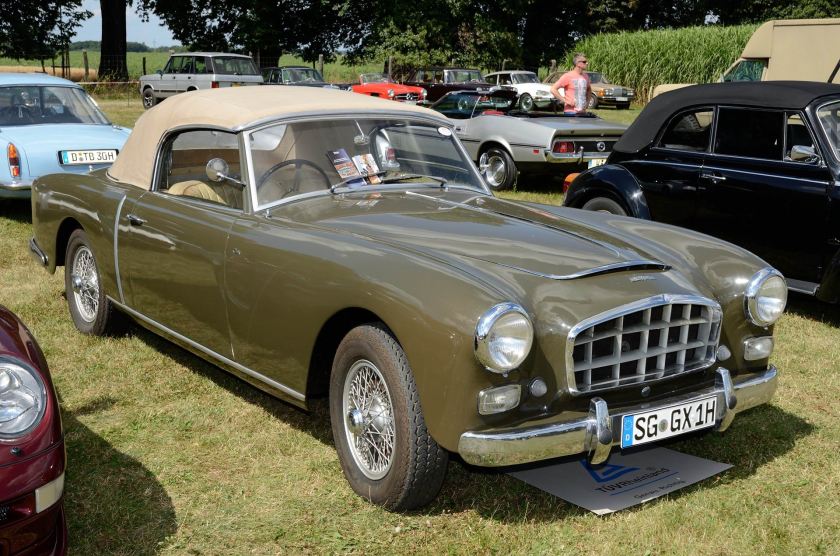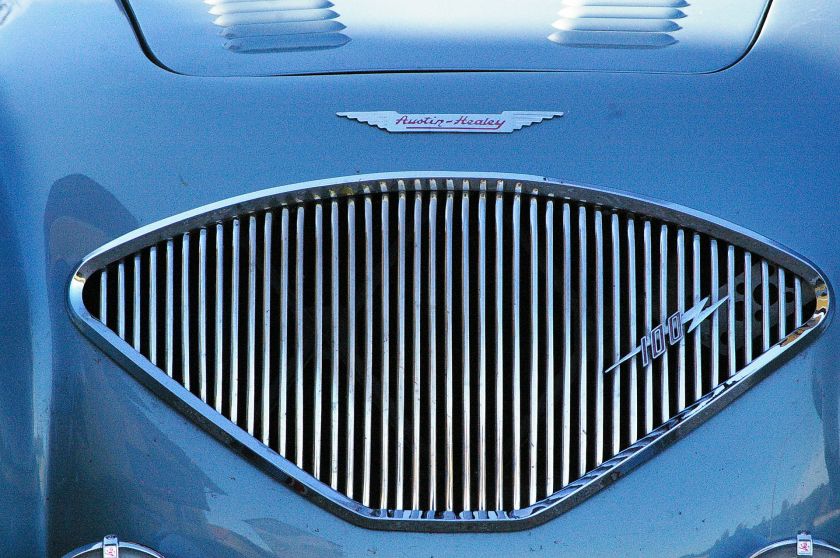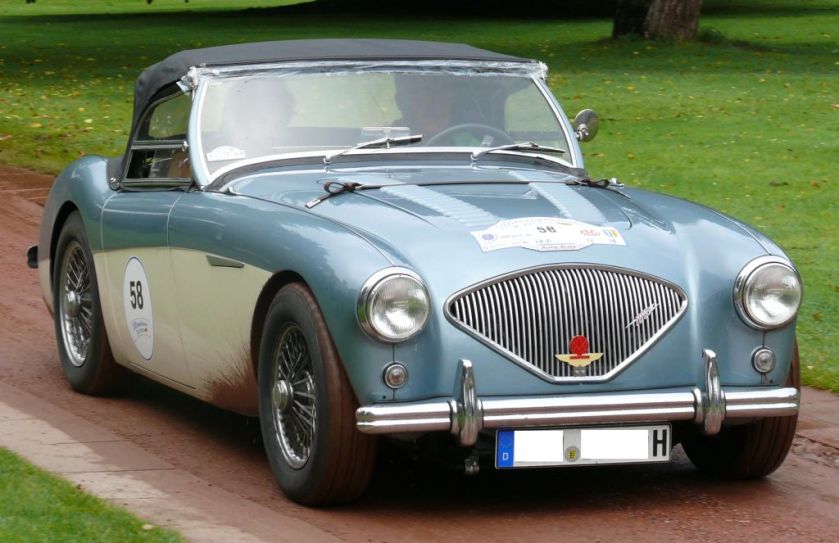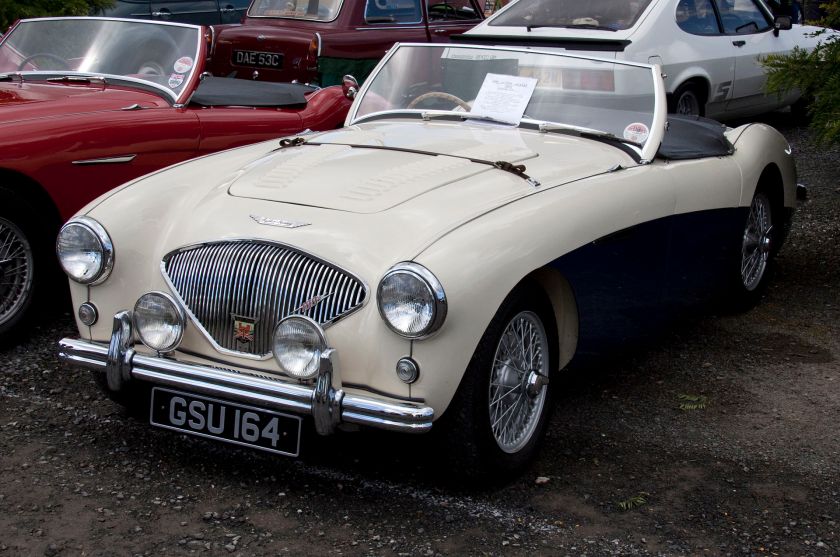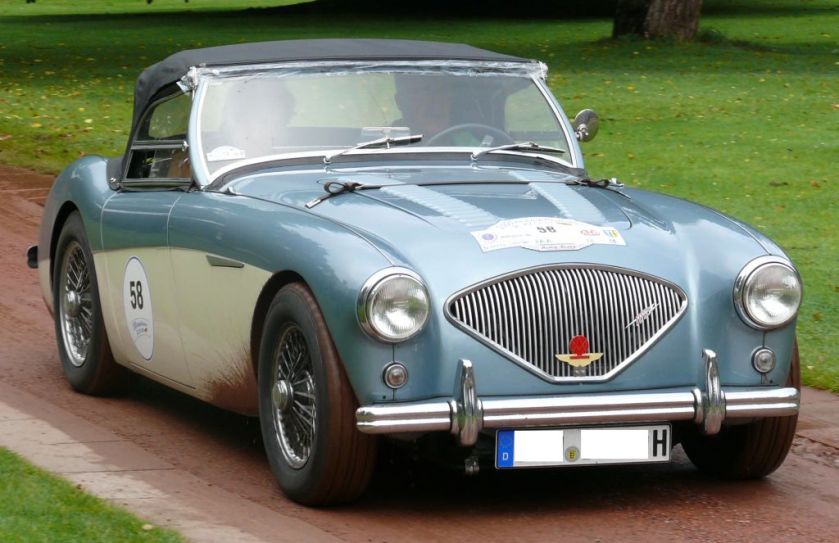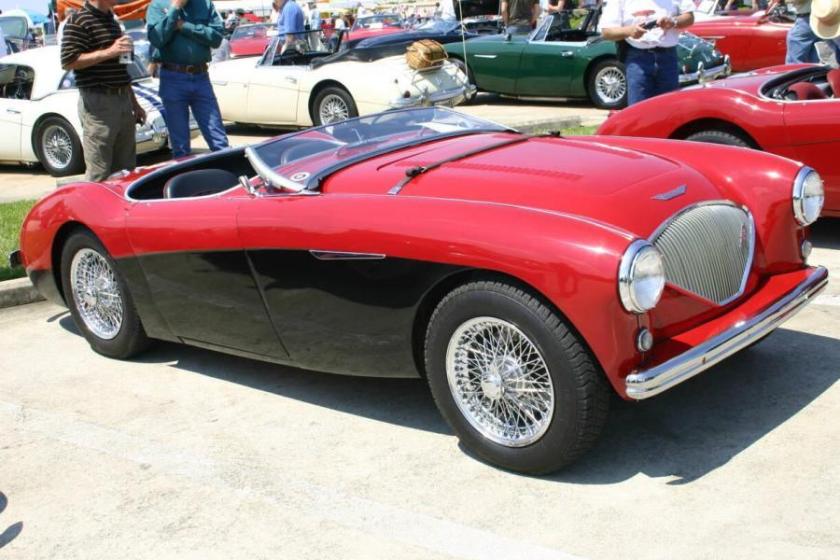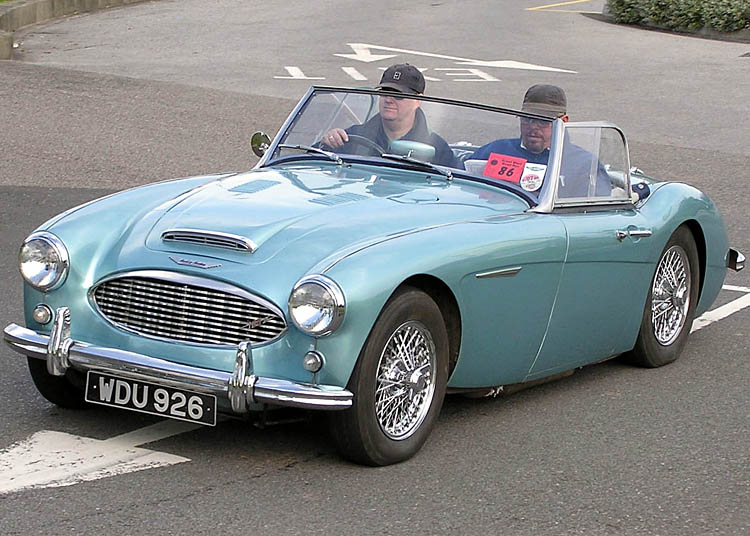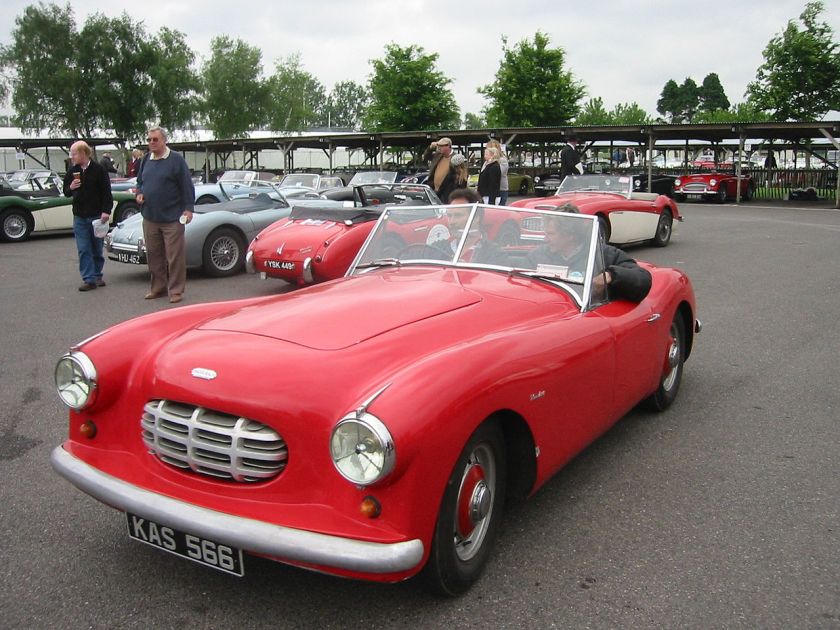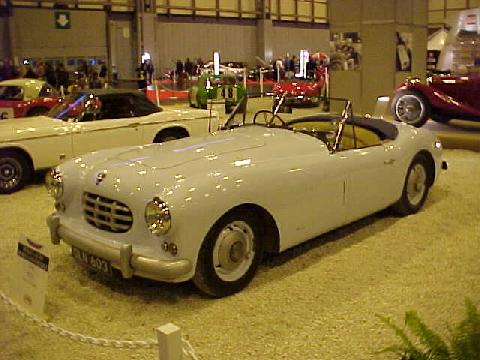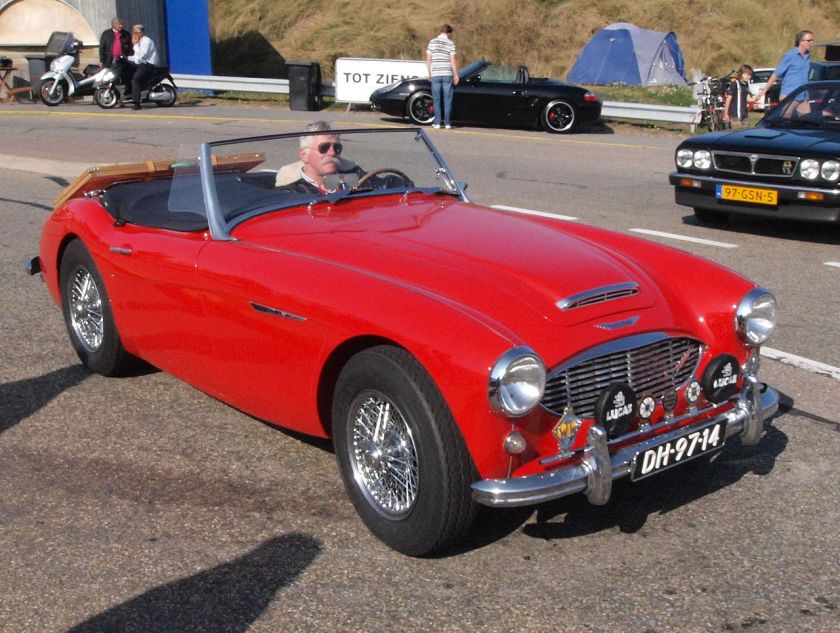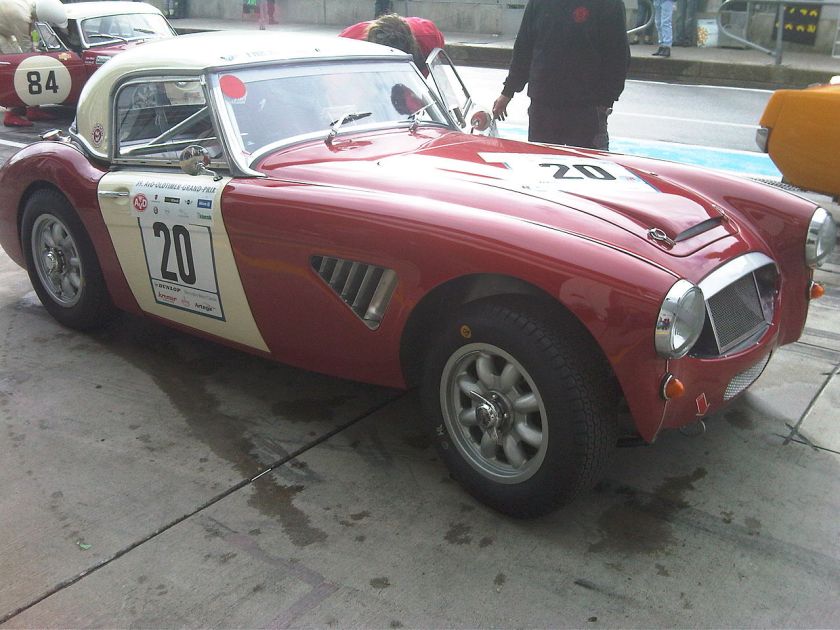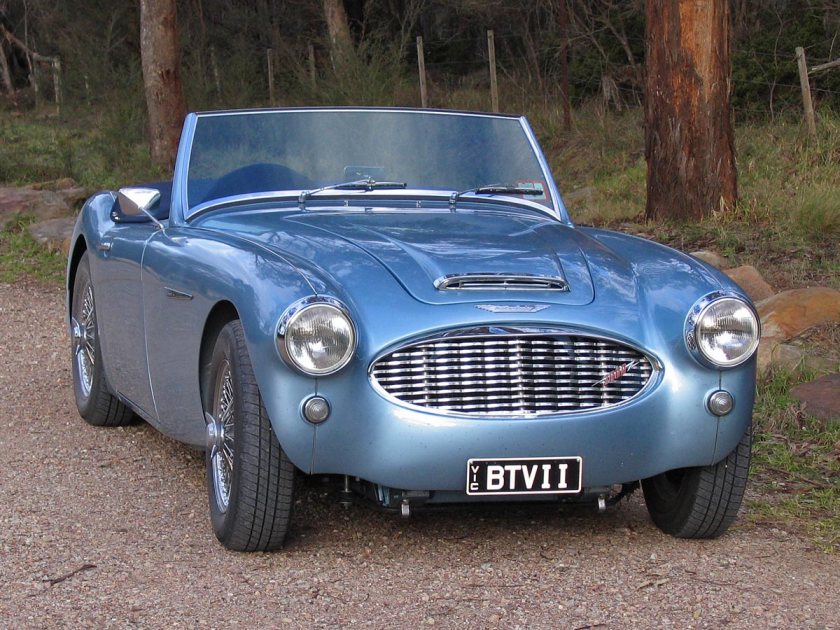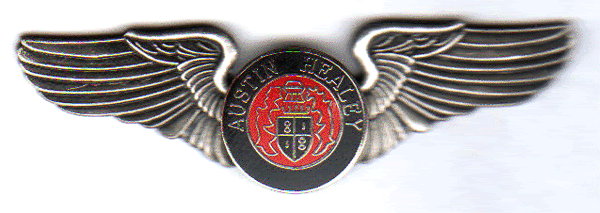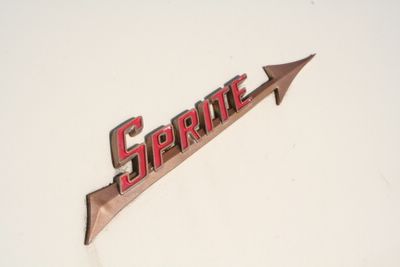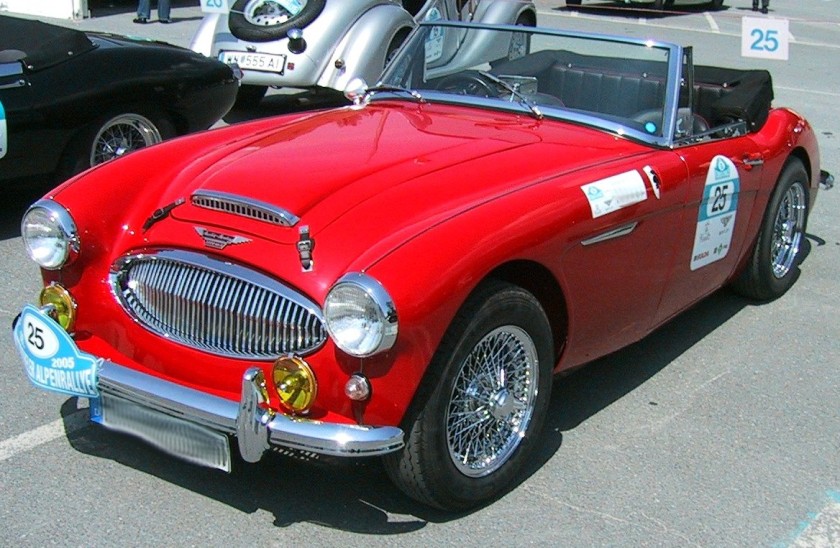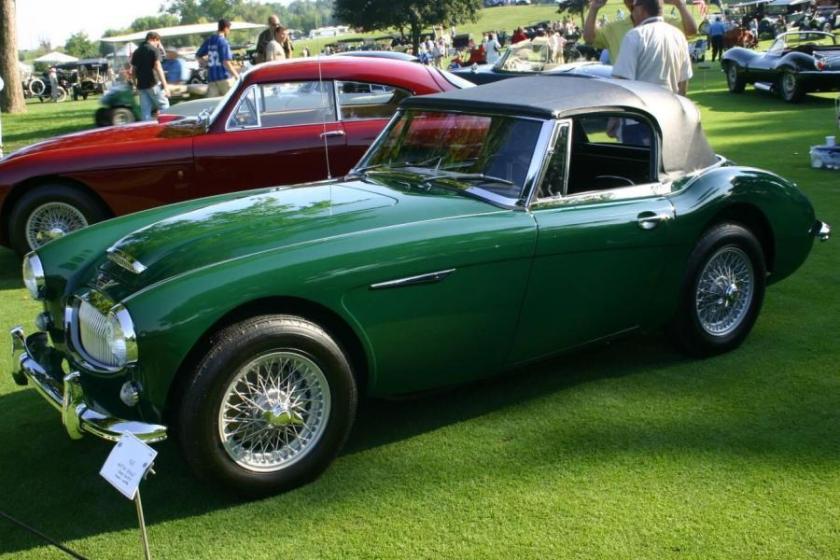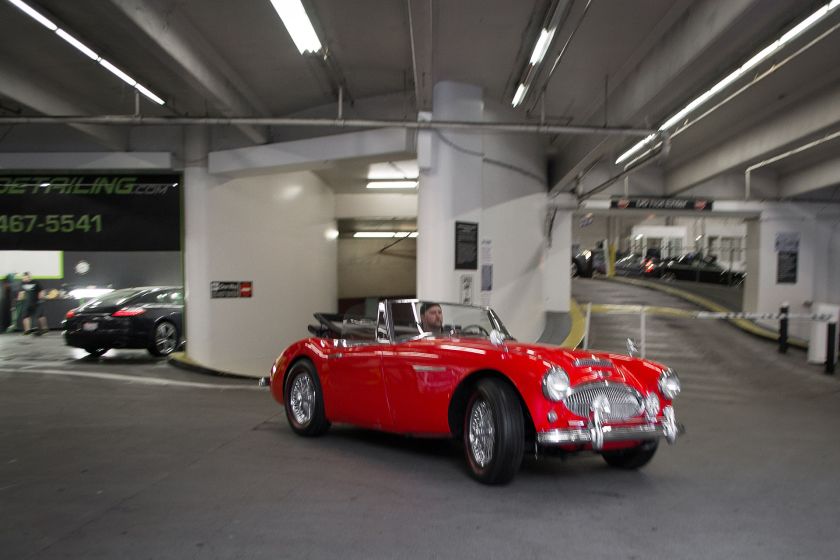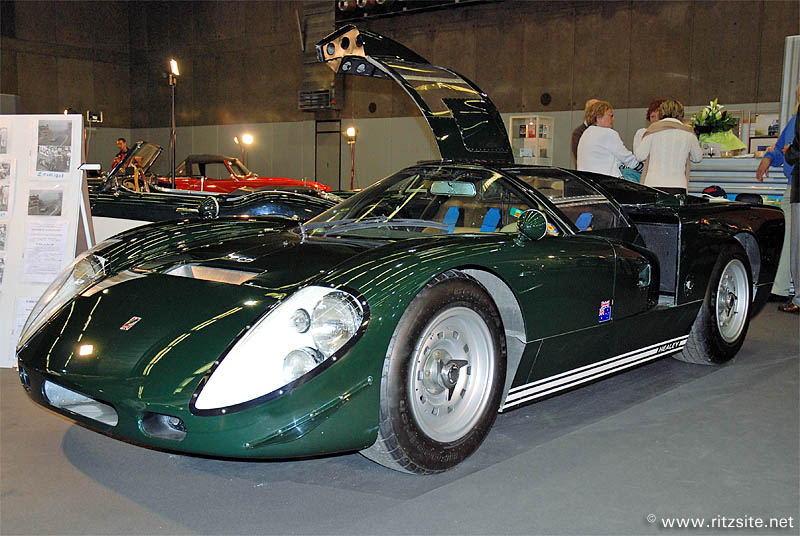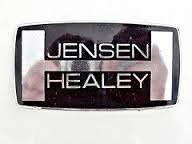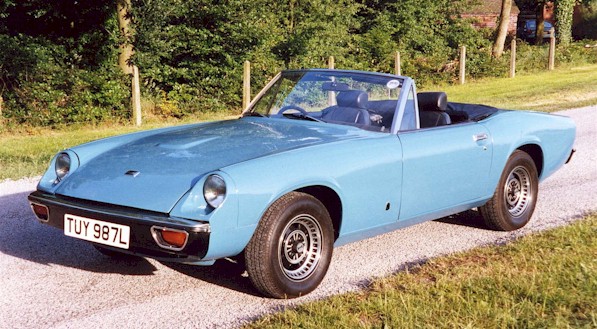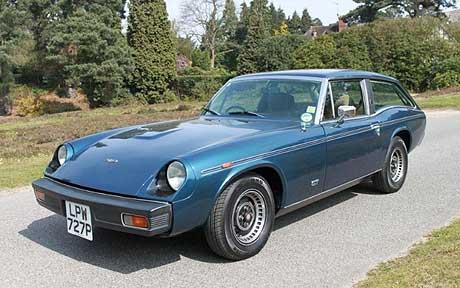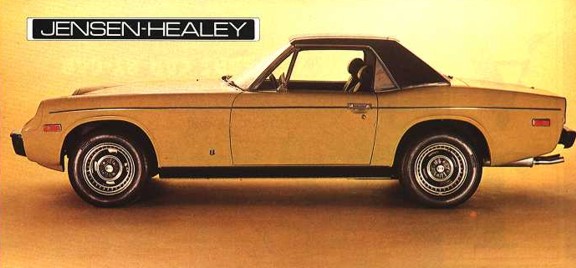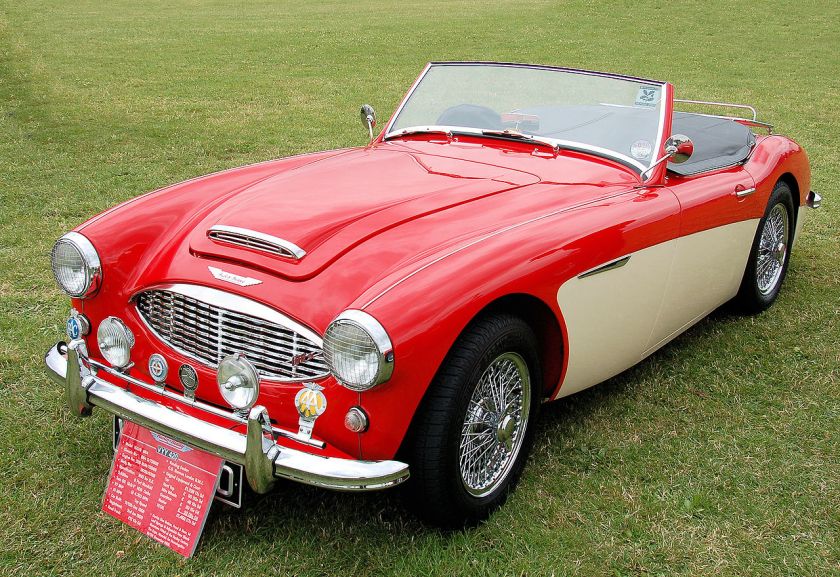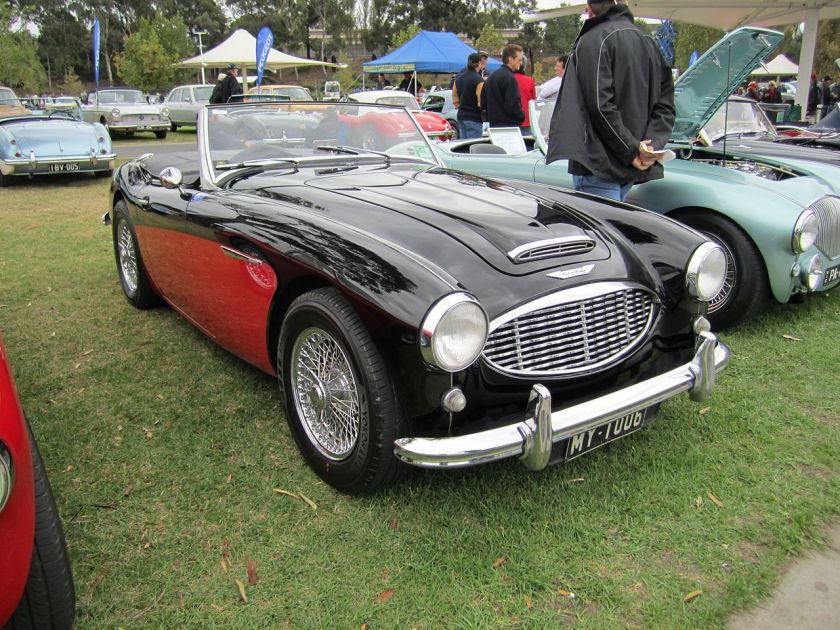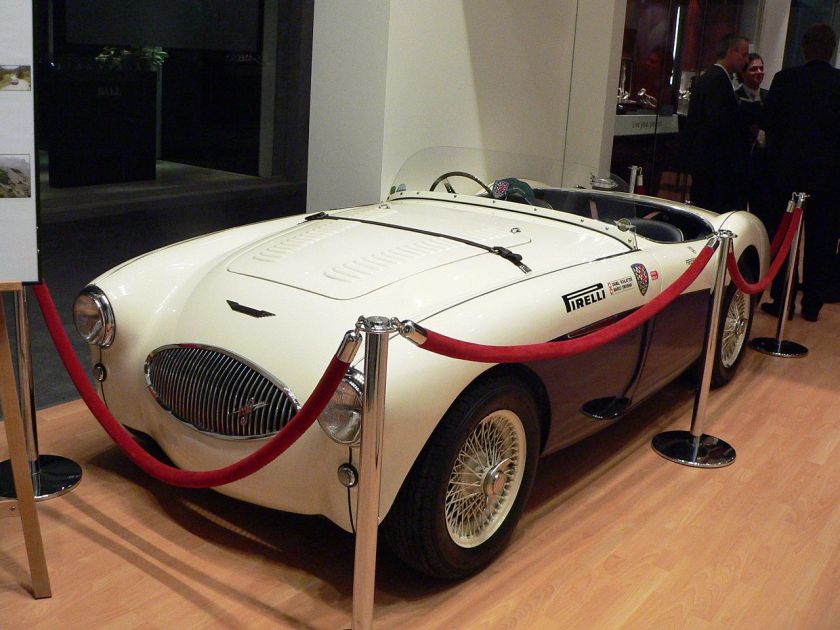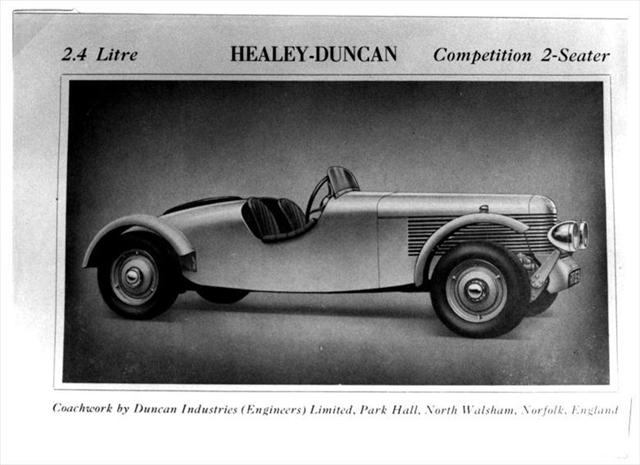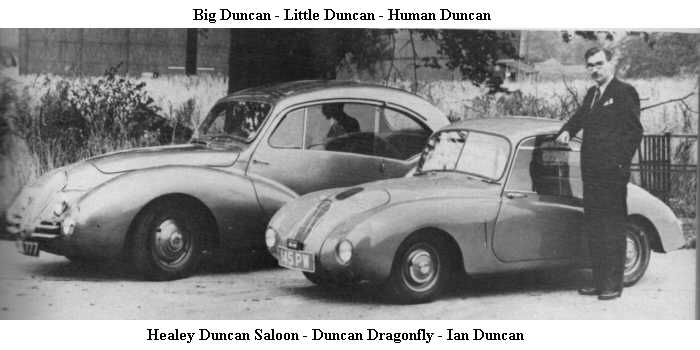Donald Healey Motor Company
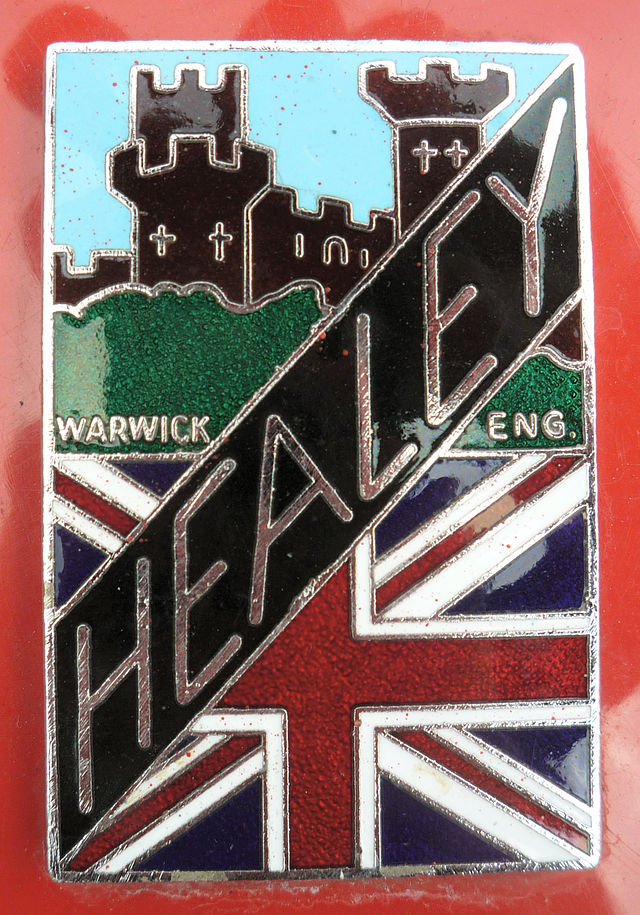 |
|
| Industry | Manufacture of high performance cars and design consultancy |
|---|---|
| Fate | Sold |
| Founded | 1945 |
| Headquarters | The Cape, Warwick United Kingdom |
|
Key people
|
Donald Healey – founder |
| Slogan | The fastest car in the world in series production |
Donald Healey Motor Company Limited was a British car manufacturer.
History
The business was founded in 1945 by Donald Healey, a successful car designer and rally driver. Healey discussed sports car design with Achille Sampietro, a chassis specialist for high performance cars and Ben Bowden, a body engineer, when all three worked at Humber during World War II.
Healey motorcars
Healey’s new enterprise focused on producing expensive, high quality, high performance cars. It was based in an old aircraft components factory off Miller Road in Warwick. There he was joined by Roger Menadue from Armstrong Whitworth to run the experimental workshop. In later years they also had a now-demolished showroom (formerly a cinema) on Emscote Road, Warwick, commemorated by a new block of flats called Healey Court. The cars mainly used a tuned version of the proven Riley twin cam 2.4 litre four cylinder engine in a light steel box section chassis of their own design using independent front suspension by coil springs and alloy trailing arms with Girling dampers. The rear suspension used a Riley live axle with coil springs again. Advanced design allowed soft springing to be combined with excellent road holding. Lockheed hydraulic brakes were used.
When it was introduced in 1948 the Elliott saloon was claimed to be the fastest production closed car in the world, it was timed at 104.7 mph over a mile. The aerodynamic body design was the work of Benjamin Bowden, Benjamin Bowden and unusually for the time it was tested in a wind tunnel to refine its efficiency. In 1949 the most sporting of all the Healeys, the Silverstone, was announced. It had a shorter chassis and stiffer springing and was capable of 107 mph. It is now a highly sought after car and many of the other Healeys have been converted into Silverstone replicas. These cars had numerous competition successes including class wins in the 1947 and 1948 Alpine rallies and the 1949 Mille Miglia.
Nash-Healey
1953-clark-kent-he-drove-a-nash-healey
Government planning and controls required any substantial expansion of production to be for the export market alone. So in 1950 Healey built the Nash-Healey using a Nash Ambassador engine with SU carburettors and Nash gearbox. Initially the 3848 cc unit was used but when in 1952 body construction was transferred from Healey to Pininfarina the larger 4138 cc engine was fitted.
Production numbers
The final Healey car of this era was the G-Type using an Alvis TB21 engine and gearbox. This was more luxurious and heavier than the Riley engined models and performance suffered.
| Type | Engine | Approx Production | Year |
|---|---|---|---|
| Healey Westland Roadster | 2443 cc Riley 4 cylinder | 64 | 1946-50 |
| Healey Elliott Saloon | 2443 cc Riley 4 cylinder | 101 | 1946-50 |
| Healey Sportsmobile | 2443 cc Riley 4 cylinder | 23 | 1948-50 |
| Healey Silverstone | 2443 cc Riley 4 cylinder | 104 | 1949-50 |
| Healey Tickford Saloon | 2443 cc Riley 4 cylinder | 222 | 1950-54 |
| Healey Abbott Drophead Coupe | 2443 cc Riley 4 cylinder | 77 | 1950-54 |
| Nash-Healey | 3848 or 4138 cc Nash 6 cylinder | 506 | 1950-54 |
| Healey G-Type Roadster | 2993 cc Alvis 6 cylinder | 25 | 1951-53 |
- Riley engined cars

-
Westland
“Woody” brake
(ca 1950)
AUSTIN – HEALEY
Austin-Healey
Austin-Healey was a British sports car maker established in 1952 through a joint venture between the Austin division of the British Motor Corporation (BMC) and the Donald Healey Motor Company (Healey), a renowned automotive engineering and design firm. Leonard Lord represented BMC and Donald Healey his firm.
BMC merged with Jaguar Cars in 1966 to form British Motor Holdings (BMH). Donald Healey left BMH in 1968 when it merged into British Leyland. Healey then joined Jensen Motors, which had been making bodies for the “big Healeys” since their inception in 1952, and became their chairman in 1972. Austin-Healey cars were produced until 1972 when the 20-year agreement between Healey and Austin came to an end.
Models built
Austin-Healey 100
Austin-Healey 100
| Austin-Healey 100 | |
|---|---|
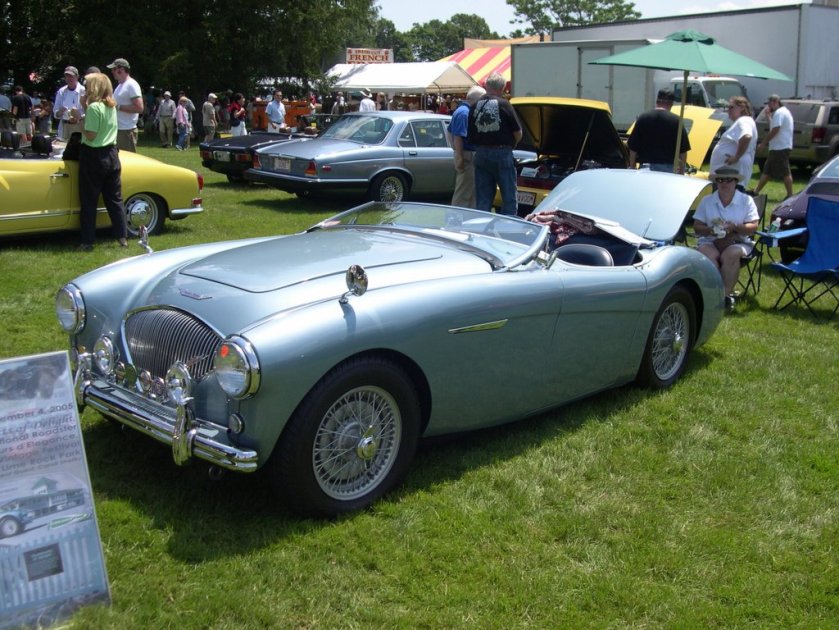 |
|
| Overview | |
| Production | 1953–56 14,634 produced plus an additional fifty 100S and five special test cars |
| Assembly | Longbridge, England West Bromwich, England |
| Powertrain | |
| Engine | 2660 cc I4 |
| Transmission | 3-speed (series BN1) or 4-speed (series BN2) manual |
| Dimensions | |
| Wheelbase | 90 in (2,286 mm) |
| Length | 151 in (3,835 mm) |
| Width | 60 in (1,524 mm) |
| Height | 49.25 in (1,251 mm) |
| Chronology | |
| Successor | Austin-Healey 100-Six |
The Austin-Healey 100 is a sports car built from 1953 until 1956.
It was developed by Donald Healey to be produced in-house by Healey’s small car company in Warwick and based on Austin A90 Atlantic mechanicals. Healey built a single Healey Hundred for the 1952 London Motor Show, and the design impressed Leonard Lord, managing director of Austin, who was looking for a replacement to the unsuccessful A90. Lord struck a deal with Healey to build it in quantity, bodies made by Jensen Motors were given Austin mechanical components at Austin’s Longbridge factory. The car was renamed the Austin-Healey 100.
The “100” was named by Healey for the car’s ability to reach 100 mph (160 km/h); its successor, the better known Austin-Healey 3000, was named for the 3000 cc displacement of its engine.
Production Austin-Healey 100s were finished at Austin’s Longbridge plant alongside the A90 and based on fully trimmed and painted body/chassis units produced by Jensen in West Bromwich—in an arrangement the two companies previously had explored with the Austin A40 Sports.
The 100 was the first of three models later called the Big Healeys to distinguish them from the much smaller Austin-Healey Sprite. The Big Healeys are often referred to by their three-character model designatorsrather than by their models, as the model names do not reflect the mechanical differences and similarities well.
BN1
The first 100s (series “BN1”) were equipped with the same undersquare 87.3 mm (3.4 in) bore and 111.1 mm (4.4 in) stroke 90 bhp (67 kW) 2660 cc I4 engines and manual transmission as the stock A90, but the transmission was modified to be a three-speed unit with overdrive on second and top.
Girling 11 in (279.4 mm) drum brakes were fitted all round. Front suspension was independent using coil springs and at the rear a rigid axle with semi elliptic leaf springs. The steering was cam and lever.
A BN1 tested by The Motor magazine in 1953 had a top speed of 106 mph (171 km/h) and could accelerate from 0–60 mph (97 km/h) in 11.2 seconds. A fuel consumption of 22.5 miles per imperial gallon (12.6 L/100 km; 18.7 mpg-US) was recorded. The test car cost £1063 including taxes.
A total of 10030 BN1s were built from May 1953 until replaced by the BN2 model in August 1955.
BN2
The BN2 was fitted with a real four-speed manual transmission, still with overdrive on the top two gears. Other features that distinguish the BN2 from the BN1 are the slightly larger front wheel arches, different rear axle and being the first 100 with optional two-tone paint.
- In 1955, a high-performance 100M model was introduced, with larger carburettors, a cold air box to increase engine air flow, high-lift camshaft and 8.1:1 compression pistons. It produced 110 bhp (82 kW) at 4500 rpm. The front suspension was stiffened and the bonnet gained louvres, along with a bonnet belt. Approximately 70% of 100Ms were finished with a two-tone paint scheme, including one White over Red and another in Black over Pink for display at the 1955 London Motor Show. In all, 640 100Ms were built by the factory.
- The 100M components (except for the high compression pistons) were also available as the Le Mans Engine Modification Kit, which could be installed in either a BN1 or BN2 with the engine in situ, improving the power output to approximately 100 bhp (75 kW) at 4500 rpm. The kit could be ordered from BMC, allowing private owners to make their own modifications.
The BN2 was available in Reno Red, Spruce Green, Healey Blue, Florida Green, Old English White, Black, and approximately 50 Gunmetal Grey cars. Two-tone options were: White/Black; Reno Red/Black; Healey Blue/White; Black/Reno Red; and Florida Green/White
By January 1956 production was running at 200 cars each month and sales in California 150 cars each month.
The final BN2 was built in July 1956, with a total of 4604 BN2s produced, including the 100M.
100S
Built primarily with racing in mind, the aluminium-bodied “100S” (for Sebring) model developed 132 bhp (98 kW) at 4700 rpm. Only 50 production cars were made, plus an additional five works development/special test cars hand built by the Donald Healey Motor Company at Warwick. To minimize weight the cast iron cylinder head was replaced by an aluminium one, and the overdrive unit was not installed. Brakes were discs all-round, the world’s first production car to feature them both front and rear. To further lighten the vehicle, bumpers and hood (convertible top) were eliminated, the grille reduced in size, and the windscreen made of plastic. In all, weight was reduced by approximately 200 lb (91 kg). The majority of 100Ss were two-toned white with Lobelia Blue sides. A handful were produced in solid Spruce Green and red, and single one in black.
An unrestored works racing team 1953 Austin-Healey ‘100S’ Special Test Car that had been campaigned by factory drivers Lance Macklin, Gordon Wilkins and Marcel Becquart, sold for a world record £843,000 ($1,323,915) 1 December 2011, at Bonhams’ December Sale. This car was involved in the 1955 Le Mans disaster, motor racing’s most lethal crash—in which 84 people died and 120 were injured.
Big Healeys
Model designators
- See Austin-Healey#Models built for a more detailed listing
- 100: 2-seat
- BN1: 3 speed +OD, 1952–55
- BN2: 4 speed +OD, 1955–56
- AHS: 1955
- 100/6
- BN4: 2+2, 1956–59
- BN6 2-seat. 1958–59
- 3000 Mk I
- BN7 2-seat. 1959–61
- BT7 2+2, 1959–61
- 3000 Mk II
- BN7 2-seat, 1961–62
- BT7 2+2, 1961–62
- BJ7 2+2, 1962–63
- 3000 Mk III
- BJ8 Phase 1 2+2, 1964
- BJ8 Phase 2 2+2, 1964–68
Austin-Healey 3000
| Austin-Healey 3000 | |
|---|---|
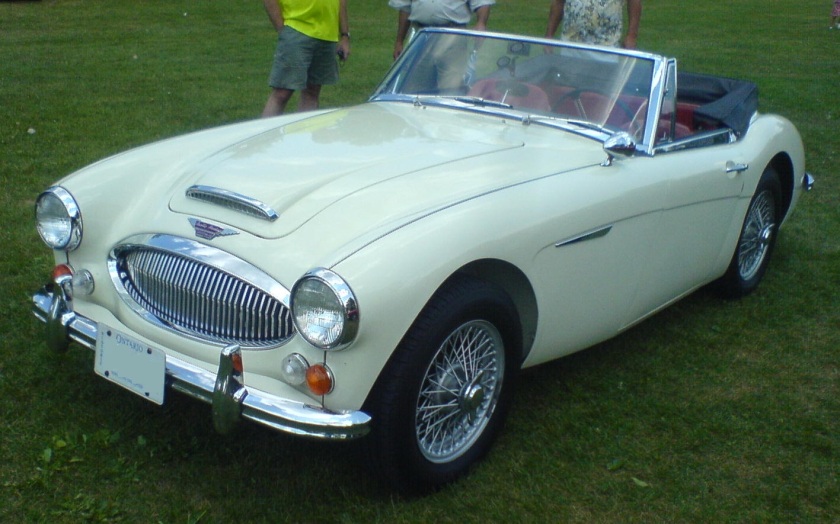 |
|
| Overview | |
| Manufacturer | Austin-Healey |
| Production | 1959–1967 42,926 |
| Assembly | Abingdon, England |
| Body and chassis | |
| Class | Sports car |
| Body style | 2-door roadster |
| Layout | FR layout |
| Powertrain | |
| Engine | 2,912 cc (2.9 L) C-Series I6 |
| Dimensions | |
| Wheelbase | 92 in (2,337 mm) |
| Length | 157 in (3,988 mm) |
| Width | 60 in (1,524 mm) |
| Height | 46 in (1,168 mm) (Hood down) 49.5 in (1,257 mm) (hard top) |
| Curb weight | 2,550 lb (1,157 kg) |
| Chronology | |
| Predecessor | Austin-Healey 100-6 |
| Successor | MG MGC |
The Austin-Healey 3000 is a British sports car built from 1959 to 1967, and is the best known of the “big Healey” models. The car’s bodywork was made by Jensen Motors, and the vehicles were assembled at theBMC Abingdon works.
The 3-litre 3000 was a highly successful car, which won its class in many European rallies in its heyday and is still raced in classic car competitions by enthusiasts today.
History
The Austin-Healey 3000 was introduced in 1959, replacing the Austin-Healey 100-6. Despite its new name, the changes were minor compared to those between the original 100 and the 100-6. The wheelbase and body were unchanged, as were the models, a 2+2 and a two-seater.
Mark I
The original 3000 was built from March 1959 to March 1961 as models BN7 Mark I (2-seater) and BT7 Mark I (2+2 version). It only became known as the Mark I after the Mark II was released, having no designator prior. It featured a 2912 cc I6 engine, with twin SU carburetors and Girling front disc brakes. Wire wheels, overdrive gearbox, laminated windscreen, heater, adjustable steering column, detachable hard top, and two-tone paint were available as options.
A total of 13,650 Mark Is were made (2,825 BN7, and 10,825 BT7).
A BT7 3000 with hardtop and overdrive tested by The Motor magazine in 1960 had a top speed of 115 mph (185 km/h) and could accelerate from 0–60 mph (97 km/h) in 11.7 seconds. A fuel consumption of 21.6 miles per imperial gallon (13.1 L/100 km; 18.0 mpg-US) was recorded. The test car cost £1326 including taxes.
Mark II
Introduced in March 1961 as the BN7 Mark II (2-seat) and BT7 Mark II (2+2), the 3000 Mark II series came with three SU HS4 carburettors and an improved camshaft. However, the triple SUs proved difficult to balance and were replaced with two SU HS6 upon the introduction of the BJ7 (2+2) model in January 1962. With its debut the BN7 Mark II was discontinued in March 1962, and the BT7 Mark II in June 1962.
Other changes included a vertical barred front grille, wind-up windows instead of side curtains, an improved hood, and a wrap-around windscreen. Optional extras were similar to the Mark I, although the factory hardtop option was dropped with the BJ7’s introduction. From August 1961 a brake servo was also available as an optional extra, which greatly improved braking performance. The BJ7 was discontinued in October 1963 with the introduction of the 3000 Mark III.
A 3000 Mark II BT7 with hardtop and overdrive tested by the British magazine The Motor in 1961 had a top speed of 112.9 mph (181.7 km/h) and could accelerate from 0–60 mph (97 km/h) in 10.9 seconds. A fuel consumption of 23.5 miles per imperial gallon (12.0 L/100 km; 19.6 mpg-US) was recorded. The test car cost £1362 including taxes.
A total of 11,564 were made: 355 BN7 Mark II, 5,096 BT7 Mark II, and 6,113 BJ7.
Mark III
The 3000 Mark III was launched in October 1963, and remained in production until the end of 1967, when manufacture of Austin-Healeys ceased. Only one further car was built in March 1968. Designated the BJ8, the 2+2 Mark III was the most powerful and luxurious of the big Healeys, with a standard walnut-veneer dash, wind-up windows, and a 150 hp (112 kW) engine. Added power came from a new camshaft and valve springs, twin SU 2″ HD8 carburetors, and new of exhaust system design. Servo-assisted brakes were also standard. Options remained otherwise the same, except that the standard interior trim was downgraded to Ambla vinyl, with leather extra.
In May 1964 the Phase II version of the Mark III was released, which gained ground clearance through a modified rear chassis. In March 1965 the car received separate indicators.
A total of 17,712 Mark IIIs were made.
Austin Healey 3000’s have a long competition history, and raced at most major racing circuits around the world, including Sebring (USA), Le Mans (France), and Mount Panorama Circuit, Bathurst (Australia). The BMC competitions department rallied the 3000 from its introduction, but the development of the works cars effectively ended in 1965, mainly because of the success of the Mini Cooper ‘S’.
Austin-Healey Sprite
| Austin-Healey Sprite | |
|---|---|
| Overview | |
| Manufacturer | Austin-Healey |
| Also called | Austin Sprite |
| Production | 1958–71 129,347 made |
| Assembly | Abingdon, England Enfield, New South Wales, Australia |
| Body and chassis | |
| Class | Sports car |
| Body style | 2-door roadster |
| Layout | FR layout |
| Related | MG Midget |
The Austin-Healey Sprite is a small open sports car that was announced to the press in Monte Carlo by the British Motor Corporation (BMC) on 20 May 1958, just before that year’s Monaco Grand Prix. It was intended to be a low-cost model that “a chap could keep in his bike shed”, yet be the successor to the sporting versions of the pre-war Austin Seven. The Sprite was designed by the Donald Healey Motor Company, which received a royalty payment from the manufacturers BMC. It first went on sale at a price of £669, using a tuned version of the Austin A-Series engine and as many other components from existing cars as possible to keep costs down.
The Sprite was made at the MG sports car factory at Abingdon and it was inevitable that the success of the design would spawn an MG version known as the Midget, reviving a popular pre-war model name. Enthusiasts often refer to Sprites and MG Midgets collectively as “Spridgets.”
Mark I
| Mark I | |
|---|---|
|
Austin-Healey Sprite 1960
|
|
| Overview | |
| Production | 1958–61 48,987 made |
| Designer | Donald Healey |
| Powertrain | |
| Engine | 948 cc (0.9 L) A-Series I4 43HP |
| Dimensions | |
| Wheelbase | 2,032 mm (80.0 in) |
| Length | 3,480 mm (137.0 in) |
| Width | 1,346 mm (53.0 in) |
| Height | 47.25 in (1,200 mm) (with hood up) |
The little Sprite quickly became affectionately known as the Frogeye in the UK and the Bugeye in the US, because its headlights were prominently mounted on top of the bonnet, inboard of the front wings. The car’s designers had intended that the headlights could be retracted, with the lenses facing skyward when not in use; a similar arrangement was used many years later on the Porsche 928. But cost cutting by BMC led to the flip-up mechanism being deleted, therefore the headlights were simply fixed in a permanently upright position, giving the car its most distinctive feature. The body was styled by Gerry Coker, with subsequent alterations by Les Ireland following Coker’s emigration to the US in 1957. The car’s distinctive frontal styling bore a strong resemblance to the defunct American 1951 Crosley Super Sport.
The problem of providing a rigid structure to an open-topped sports car was resolved by Barry Bilbie, Healey’s chassis designer, who adapted the idea provided by the Jaguar D-type, with rear suspension forces routed through the bodyshell’s floor pan. The Sprite’s chassis design was the world’s first volume-production sports car to use unitary construction, where the sheet metal body panels (apart from the bonnet) take many of the structural stresses. The original metal gauge (thickness of steel) of the rear structure specified by Bilbie was reduced by the Austin Design Office during prototype build, however during testing at M.I.R.A. (Motor Industry Research Association) distortion and deformation of the rear structure occurred and the original specification was reinstated. The two front chassis legs projecting forward from the passenger compartment mean the shell is not a full monocoque. The front sheet-metal assembly, including the bonnet (hood) and wings, was a one-piece unit, hinged from the back, that swung up to allow access to the engine compartment.
The 43 bhp, 948 cc OHV engine (coded 9CC) was derived from the Austin A35 & Morris Minor 1000 models, also BMC products, but upgraded with twin 11⁄8” inch SU carburettors. The rack and pinion steering was derived from the Morris Minor 1000 and the front suspension from the Austin A35. The front suspension was a coil spring and wishbone arrangement, with the arm of the Armstrong lever shock absorber serving as the top suspension link. The rear axle was both located and sprung by quarter-elliptic leaf springs, again with lever-arm shock absorbers and top links. There were no exterior door handles; the driver and passenger were required to reach inside to open the door. There was also no boot lid, owing to the need to retain as much structural integrity as possible, and access to the spare wheel and luggage compartment was achieved by tilting the seat-backs forward and reaching under the rear deck, a process likened to potholing by many owners, but which resulted in a large space available to store soft baggage.
Engine:
A car was tested by the British magazine The Motor in 1958. It had a top speed of 82.9 mph (133.4 km/h) and could accelerate from 0-60 mph (97 km/h) in 20.5 seconds. Fuel consumption of 43 miles per imperial gallon (6.6 L/100 km; 36 mpg-US) was recorded. The test car cost £678, including taxes of £223.
The BMC Competition Department entered Austin Healey Sprites in major international races and rallies, their first major success coming when John Sprinzel and Willy Cave won their class on the 1958 Alpine Rally. Private competitors also competed with much success in Sprites. Because of its affordability and practicality, the Austin Healey Sprite was developed into a formidable competition car, assuming many variants by John Sprinzel, Speedwell and WSM. The Sebring Sprite became the most iconic of the racing breed of Austin Healey Sprites. Many owners use their Austin Healey Sprites in competition today, fifty years after its introduction.
Mark II
| Mark II | |
|---|---|
Austin-Healey Sprite Mark II
|
|
| Overview | |
| Production | 1961–64 31,665 made |
| Body and chassis | |
| Related | MG Midget MkI |
| Powertrain | |
| Engine | 948 cc (0.9 L) later 1,098 cc (1.1 L) A-Series I4 |
| Dimensions | |
| Wheelbase | 2,032 mm (80.0 in) |
| Length | 3,305 mm (130.1 in) |
| Width | 1,346 mm (53.0 in) |
| Height | 48.25 in (1,226 mm) (with roof up) |
The Mark II used the same 948 cc engine (engine code 9CG) but with larger twin 11⁄4 inch SU carburettors increasing power to 46.5 bhp and a close-ratio gearbox. The bodywork was completely revamped, with the headlights migrating to a more conventional position in the wings, either side of a full-width grille. At the rear, styling borrowed from the soon-to-be-announced MGB gave a similarly more modern look, with the added advantages of an opening boot lid and conventional rear bumper bar. The result was a much less eccentric-looking sports car, though at the expense of some 100 lbs extra weight. In contrast to the ‘frogeye’, the later cars are often collectively referred to as square-bodied Sprites by enthusiasts.
An MG version of the car was introduced in May 1961 as, ‘the new Midget,’ reviving a model name which had been a great success for the MG Car Company in the 1930s. The Midget was to prove more popular with the public than the Sprite and by 1972 had completely supplanted it within the BMC range. In October 1962 both Sprites and Midgets were given a long-stroke 1098 cc engine (engine code 10CG), which was also fitted in single carburettor form to the Austin A40 and Morris Minor 1000 (which nevertheless remained the Minor 1000). A strengthened gearbox with Porsche (baulk-ring) synchromesh was introduced to cope with the extra power – a heady 56 bhp. Front disc brakes were also introduced at the same time and wire wheels became an option.
Innocenti also produced their own version of the Sprite, using the standard production underframe (initially shipped out from England), but clothed in the sharpest of Italian suits, styled by the American Tom Tjaarda, then working at Carrozzeria Ghia. The Innocenti 950 Spider and later 1100 Spider were produced from 1961 until 1968.
A car with hardtop tested by the British magazine The Motor in 1961 had a top speed of 85.8 mph (138.1 km/h) and could accelerate from 0–60 mph (97 km/h) in 20.0 seconds. A fuel consumption of 43.5 miles per imperial gallon (6.49 L/100 km; 36.2 mpg-US) was recorded. The test car, which was to de-luxe specification cost £705 including taxes of £208.
Engines:
- 1961–64: 948 cc A-Series I4, 46 hp (34 kW) at 5500 rpm and 53 lbf·ft (72 Nm) at 3000 rpm
- 1962–64: 1098 cc A-Series I4, 56 hp (42 kW) at 5500 rpm and 62 lbf·ft (84 Nm) at 3250 rpm
Mark III
| Mark III | |
|---|---|
| Overview | |
| Production | 1964–66 25,905 made |
| Body and chassis | |
| Related | MG Midget MkII |
| Powertrain | |
| Engine | 1,098 cc (1.1 L) A-Series I4 |
| Dimensions | |
| Wheelbase | 2,032 mm (80.0 in) |
| Length | 3,461 mm (136.3 in) |
| Width | 1,397 mm (55.0 in) |
The Mark III Sprite was also marketed as the Mark II MG Midget – differences between the two were again restricted to minor trim detailing. Although still 1098 cc, the engine had a stronger block casting, and the size of the crankshaft main bearings was increased to two inches (engine code 10CC).
A new (slightly) curved-glass windscreen was introduced with hinged quarterlights and wind-up side windows. Exterior door handles were provided for the first time, with separate door locks. Though the car could now be secured, with a soft-top roof the added protection was limited. The rear suspension was modified from quarter-elliptic to semi-elliptic leaf springs, which gave a more comfortable ride for a near-negligible weight penalty as well as providing additional axle location, the upper links fitted to the quarter-elliptic models being deleted. Though scarcely sybaritic, these changes helped the Sprite and Midget compete with the recently released Triumph Spitfire.
It has been suggested here that there was a “short run of vehicles (unknown number) in late 1963 with the Mk II body/interior but with the Mk III undercarriage/suspension modifications.” Although no source is given for this assertion, the basis may be more than speculation. There are numerous recorded instances throughout Sprite and Midget production where specification changes do not precisely concur with model changes. At the very least, the prototypes for the half-elliptic models are likely to have been taken from the production line and some of these may well have been subsequently sold. However, the number of such cars would have been small.
(At least one such was exported to Italy, where it was still running until wrecked in 1971. It had the full MK III undercarriage and instrument cluster and front disc brakes, but Mk II coachwork.)
Engine:
Mark IV and Austin Sprite
| Mark IV | |
|---|---|
| Overview | |
| Also called | Austin Sprite |
| Production | 1966–71 22,790 made |
| Body and chassis | |
| Related | MG Midget MkIII |
| Powertrain | |
| Engine | 1,275 cc (1.3 L) A-Series I4 |
| Dimensions | |
| Wheelbase | 2,032 mm (80.0 in) |
| Length | 3,492 mm (137.5 in) |
| Width | 1,397 mm (55.0 in) |
The next upgrade was presented at the London Motor Show in October 1966.[7] Besides receiving the larger 1275 cc engine (which disappointed enthusiasts by being in a lower state of tune than that of the Mini-Cooper ‘S’), the Mark IV and its cousin the Mark III MG Midget had several changes which were more than cosmetic. Most notable is the change from a removable convertible top, which had to be stowed in the boot, to a permanently affixed, folding top of greatly improved design, which was much easier to use. Separate brake and clutch master cylinders were fitted, as car manufacturers’ thoughts began to turn to making their products safer. On US market versions the larger engine sacrificed some of its performance from 1968 on, through the use of smog pumps and other modifications to comply with federal emission control requirements. 1969 was the final year the Sprite was exported to the US.
For the 1970 model year cast-alloy wheels were fitted and the grille was changed to resemble that fitted to the MG Midget.
Engine:
The Healey connection was discontinued in 1971, so the final 1,022 Sprites built were simply Austin Sprites. This was a cost-cutting move of Donald Stokes‘, enabling British Leyland to stop paying royalties to theDonald Healey Motor Company. There was no direct successor, as BL’s extensive range already contained the MG Midget, which was identical to the Sprite except for badging, and the similarly dimensioned and priced Triumph Spitfire.
Competition
The Sprite (and its MG Midget sibling) have been successful club level race cars since their launch and continue to race in various events to the present day. International events were entered throughout the 1960s and surprisingly good results were achieved, including a 12th place finish at Le Mans in 1965. The works cars began with use of a commercially available fibreglass-bodied Sprite (with a Falcon body) before utilising lightweight body panels of standard appearance. By the mid-60s, use was made of the wind-tunnel at Longbridge. Barry Bilbie (the chassis designer) utilised the results to produce a streamlined body, built in Birmabright alloy at Healey’s Warwick workshops by Bill Buckingham and Terry Westwood. These cars were powered by BMC’s Courthouse Green’s tuned engines and eventually produced a reliable 110 bhp, which enabled a top speed of around 150 mph on the Mulsanne straight. One-off gearboxes were also made at Courthouse Green, with MGB gearboxes modified with an externally mounted 5th gear and overdrive in some cases. BMC works entries recorded class wins at Sebring with drivers including Stirling Moss, Bruce McLaren and Steve McQueen as well competing in the Targa Florio and Mugello sports car races.
Australian production
Sprites were imported into Australia in completely knocked down (CKD) kit form and assembled by the Pressed Metal Corporation at Enfield, in New South Wales. Models assembled in Australia included the Mk 1, 2, 2A, 3 and 3A.
Innocenti Spider and C Coupé
At the 1960 Turin Auto Show, BMC’s Italian partner Innocenti showed an attractive little Spider built upon Sprite underpinnings. The car was the first design of Tom Tjaarda‘s, drawn for Carrozzeria Ghia. Ghia’s partner firm OSIbuilt the bodyshells, when the car entered production in early 1961. The original Innocenti 950 Spider had the Frogeye’s 948 cc engine with 43 hp (32 kW), 624 of these were built. Later in 1961 an uprated 46.5 hp (35 kW) was installed. In February 1963 the 1098 cc “S” model was introduced, this also had front disc brakes to cope with the extra power. The 1100 has 58 hp (43 kW) and could also be fitted with a removable hardtop. The Spider wasn’t a mere reshelling, as the entire bulkhead was moved forward to provide longer doors and a more modern look. Unlike the spartan Frogeye, the Spider also had wind-up windows and a permanent windscreen.
The Innocenti Spider originally sold well in Italy, with production running at 13 cars per day in 1962, but it had a hard time competing against the cheaper Sprite in export markets. As more modern competitors arrived and as the British-built Sprite was modernised, sales dropped precipitously, with only 63 cars built in 1965. Thus, Innocenti presented the reworked Innocenti Coupé in September 1966, still with the same 1100 engine as seen in late Spiders. The badging on the car simply read “Innocenti C”. The Coupé’s all-new bodywork was wider and longer than the Spider’s, and the wheelbase was extended by 150 mm to 2,180 mm (85.8 in). The floorpan was reworked to allow for the seats to be mounted lower than in a Sprite, making the cabin less cramped. It was competitively priced in the Italian market, slotting nicely between the smaller Fiat 850 Coupé and the bigger Fiat 124 Sport Spider. Only 794 were built when production ended in 1968. 4,790 of the 950 Spiders were built, and 2,074 of the 1100 cc Spiders.[12]
Lenham-Healey GT Coupe
1961 Lenham-Healey GT Coupe, based upon the Austin-Healey Sprite
The Lenham Motor Company of Kent, founded in 1960, was, and still is, one of the once many “cottage industry” automotive companies providing specialist conversions based upon commercial brand platforms. Best known for its Spridget coupé conversions and the Austin-Healey based Lenham Healey, the firm also produced hard-tops for Jaguar E-types, Triumphs, the Jensen-Healey, the Lotus Elan, and for the MGB.
UK 50th anniversary celebration
On 24 May 2008, the official UK golden anniversary of the introduction of the Austin Healey Sprite, “Spridget 50 – The Big Party” was held at the British Heritage Motor Centre at Gaydon, Warwickshire. Up to 1000 Sprites, Midgets and derivatives were in attendance – a record number. The event was jointly organised and promoted by the UK’s Midget and Sprite Club, Healey Drivers Club, MG Owners Club, Austin Healey Club and MG Car Club – the first time an event of this size has been supported by all of the marque-representing clubs.
Gallery
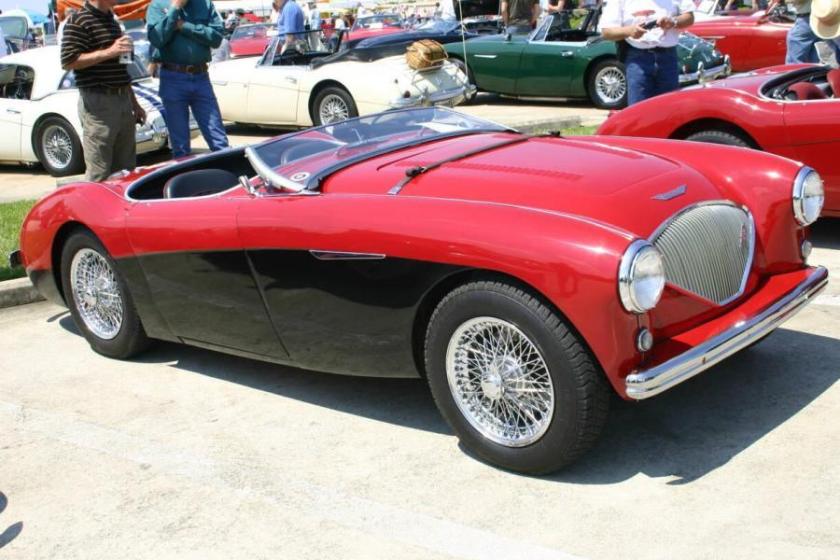 1955 Austin Healey 100M
1955 Austin Healey 100M
-
1958 Austin-Healey 100-6
-
1959 Austin-Healey 3000
-
-
1960 Austin-Healey Sprite
Concept Cars
Austin-Healey Project Tempest (2005)
Racing
The Austin Healey was extensively raced by the Donald Healey Motor Company in Europe at Le Mans and in Sebring in the U.S., in classic rallies by the BMC competitions department, and was recognized from the very beginning by the Sports Car Club of America(SCCA). Healey models raced in club racing in D, E, and F production classes, winning National Championships in both D and E Production. The last Big Healey to win an SCCA National Championship was the class E Production Austin-Healey 100-6 driven by Alan Barker at the Daytona ARRC in 1965.
In 1953, a special streamlined Austin-Healey set several land speed records at the Bonneville Salt Flats in Utah, USA.
Successors
The name Austin is now owned by Nanjing, which bought the assets of MG Rover Group (British Leyland’s successor company) out of bankruptcy in 2005. After Donald Healey sold his original business, Donald Healey Motor Company, the Healey brand was registered to a new firm, Healey Automobile Consultants, which the Healey family sold to HFI Automotive in 2005.
In June 2007, Nanjing and Healey Automobile Consultants / HFI Automotive signed a collaborative agreement that aims to recreate the Austin Healey and Healey marquees alongside NAC’s MG. No timeline has been given as to when the Healey and Austin-Healey brands will return, although MG will be back on the market in China and the UK by the year’s end.
In popular culture
- In Mad Men S7/E1: “Time Zones” (April 13, 2014), Megan picks up Don at LAX in a green,
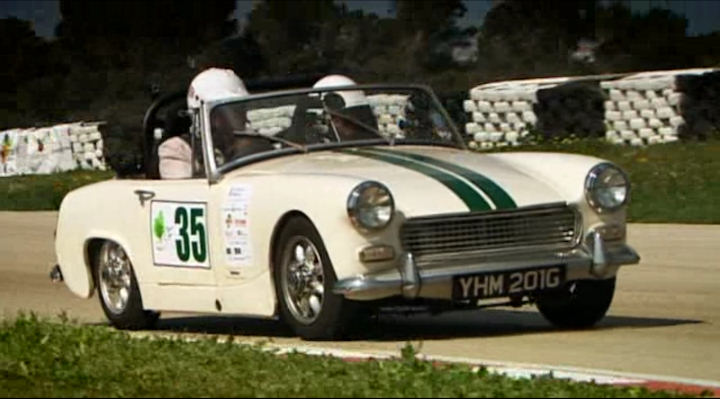 1969 Austin-Healey convertible.
1969 Austin-Healey convertible. - The video for Everybody Wants to Rule the World by Tears for Fears had Curt Smith driving a British racing green Austin-Healey 3000 around Southern Californian Landmarks including Cabazon, California and Salton Sea
See also
- Donald Healey Motor Company for the models made by the independent Healey company.
- Nash-Healey for a Nash-engined pre-Austin sports car by Donald Healey.
- Jensen-Healey for a later Donald Healey designed sports car.
- List of car manufacturers of the United Kingdom
austin-healey-sebring-sprite-coupe

